Winter in Nebraska brings a unique and diverse array of avian visitors as many bird species migrate south in search of warmer climates. However, some birds brave the cold, remaining in the state throughout winter.
Despite the harsh conditions, Nebraska’s winter birds have adapted remarkable strategies to survive the frigid temperatures and food scarcity.
From waterfowl to raptors, these birds offer a spectacle of nature and an excellent opportunity for bird watchers and nature enthusiasts to observe and appreciate the resilience and beauty of Nebraska’s winter avifauna.
This article will explore some of the fascinating winter birds that call Nebraska home during the colder months and discover how they endure and thrive in this challenging environment.
49 Winter Birds in Nebraska
Winter in Nebraska brings a unique and diverse array of avian visitors as many bird species migrate south in search of warmer climates. However, some birds brave the cold, remaining in the state throughout winter.
Here are 49 winter birds that call Nebraska home during the colder months:
1. American Goldfinch
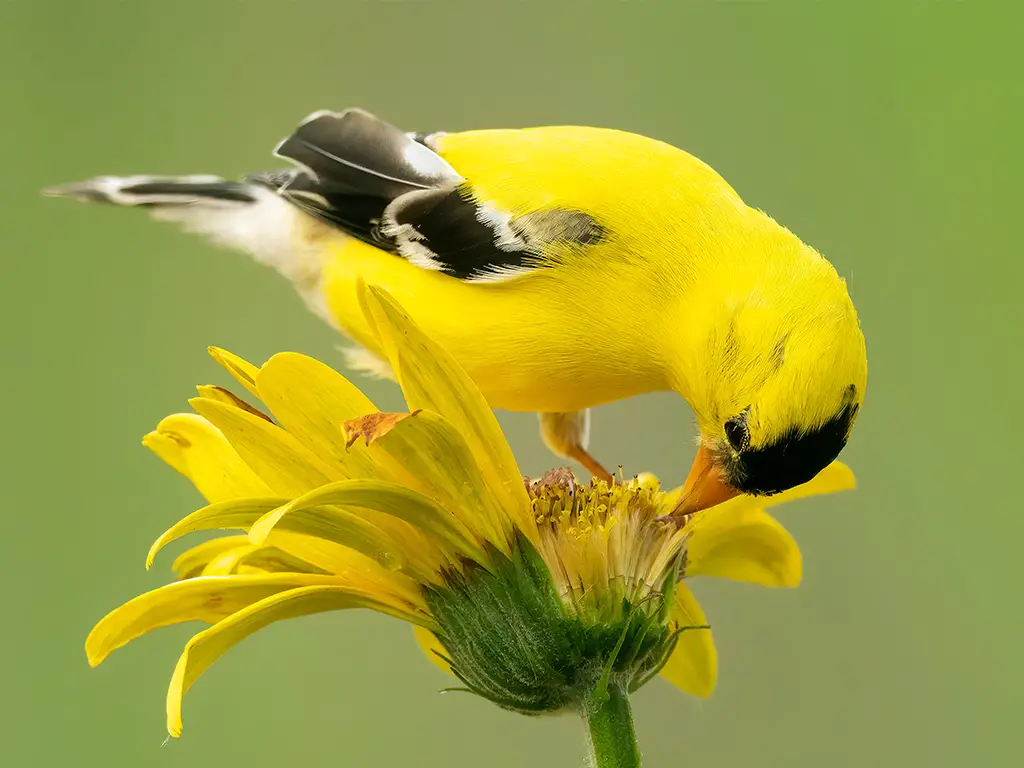
The American goldfinch is a type of bird found in North America.
It belongs to the finch family, a group of small birds known for their colorful feathers and pleasant songs. This bird is migratory, meaning it travels from one place to another depending on the time of year.
During the breeding season, when they mate and lay eggs, the American goldfinch can be found in areas ranging from mid-Alberta in Canada to North Carolina in the United States.
When the weather gets colder in the winter, the American goldfinch migrates to a different region.
They move from just south of the Canada–United States border and travel down to Mexico.
This helps them find better conditions for survival as the temperature and food availability change with the seasons. The reason for their migration is mainly related to the availability of food.
During the breeding season, the American goldfinch feeds on insects and seeds from plants like sunflowers and thistles.
These food sources are abundant in the areas where they breed, providing them with the necessary nutrients for reproduction and raising their young. However, these insects and plants may not be readily available in their breeding grounds during the winter.
| Kingdom | Animalia |
| Phylum | Chordata |
| Clade | Dinosauria |
| Class | Aves |
| Order | Passeriformes |
| Family | Fringillidae |
| Genus | Spinus |
| Species | S. tristis |
2. Northern Cardinal
The northern cardinal is a type of bird commonly referred to by different names, such as redbird, common cardinal, red cardinal, or simply cardinal.
It belongs to the genus Cardinalis. The cardinal is primarily found in North America, particularly in regions such as the United States, Canada, and Mexico. It is known for its vibrant red plumage, which is more prominent in males than females.
The male cardinal has a distinctive crest on its head, while the female has a reddish tinge on its feathers. These birds are often observed in various habitats, including woodlands, gardens, and urban areas.
They adapt to different environments and thrive in rural and suburban settings.
Cardinals are also known for their beautiful songs, which are melodic and often used for communication and territorial marking. In terms of diet, the cardinal is omnivorous, meaning it eats various foods.
Its diet comprises seeds, fruits, insects, and occasionally small reptiles or amphibians.
They have a strong beak that allows them to easily crack open seeds and fruits. Cardinals engage in courtship rituals during the breeding season, which typically occurs in spring and early summer. The male cardinal displays its vibrant red plum.
| Kingdom | Animalia |
| Phylum | Chordata |
| Clade | Dinosauria |
| Class | Aves |
| Order | Passeriformes |
| Family | Cardinalidae |
| Genus | Cardinalis |
| Species | C. cardinalis |
3. White-Breasted Nuthatch
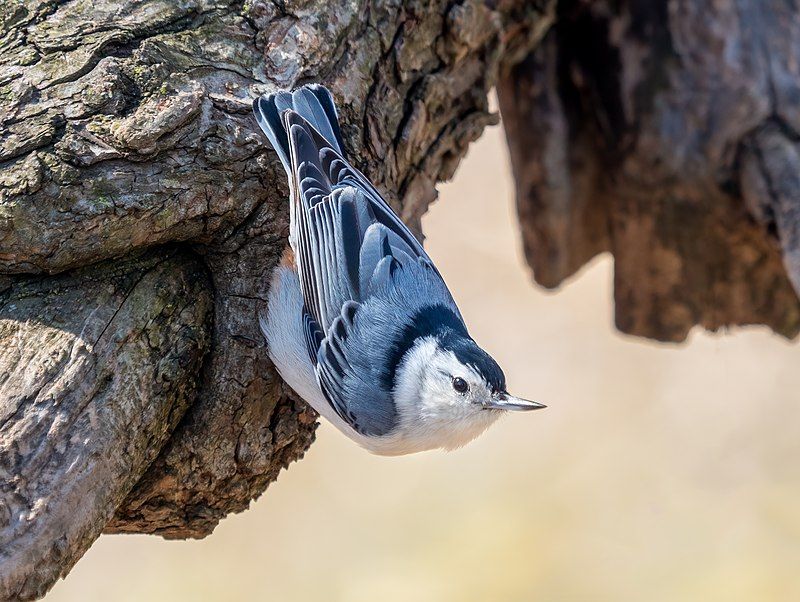
The white-breasted nuthatch is a type of bird that belongs to the nuthatch family called Sittidae.
This family includes various species of nuthatches, but we will focus on the white-breasted nuthatch in this discussion. The white-breasted nuthatch is considered a medium-sized bird, measuring around 15.5 cm in length.
This measurement gives us an idea of its size compared to other birds. While it may not be the most significant bird out there, it is also not the smallest. One exciting feature of the white-breasted nuthatch is its white breast, which gives it its name.
This white coloration on its chest stands out and helps to identify it from other species of nuthatches.
It is worth noting that not all nuthatches have this specific feature, making it unique to the white-breasted nuthatch. As a nuthatch family member, the white-breasted nuthatch shares specific characteristics with other nuthatch species.
For example, nuthatches are known for their ability to climb up and down trees headfirst. This behavior is quite fascinating to observe, as most birds can only move in an upward direction.
| Kingdom | Animalia |
| Phylum | Chordata |
| Clade | Dinosauria |
| Class | Aves |
| Order | Passeriformes |
| Family | Sittidae |
| Genus | Sitta |
| Species | S. carolinensis |
4. American Tree Sparrow
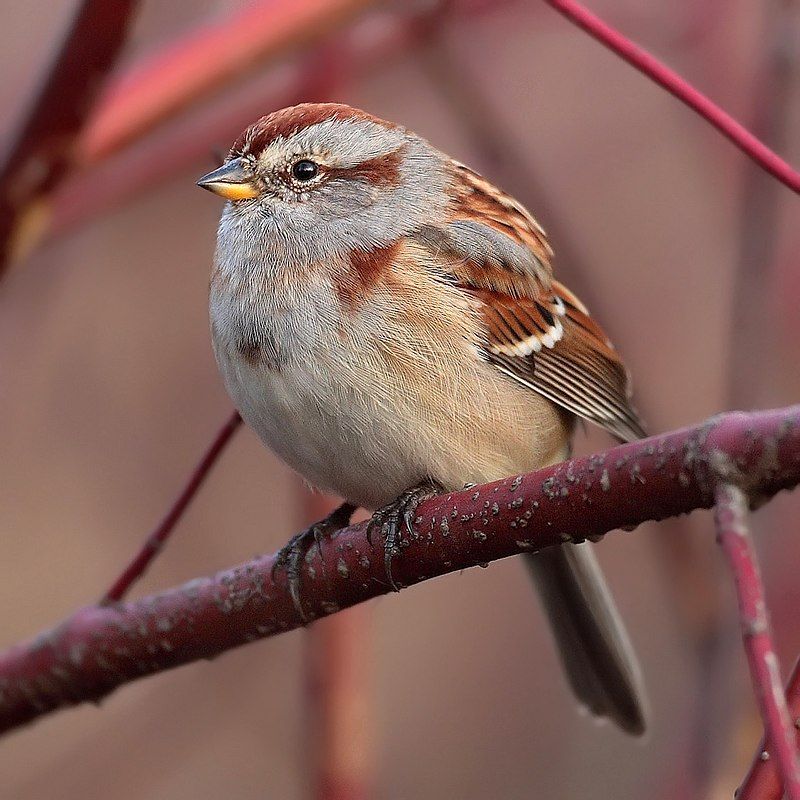
The American tree sparrow is a type of bird that is commonly found in North America. It is also known by another name, which is the winter sparrow.
This bird is medium size compared to other sparrows in the New World. The American tree sparrow is easily recognizable due to its distinct physical features.
It has a plump body with a rounded head and a short tail. Its beak is cone-shaped and designed for eating seeds.
The bird’s plumage is mostly brown and gray, with a white belly and a chestnut-colored cap on its head. During the winter, the American tree sparrow migrates from its breeding grounds in the Arctic tundra to more southern regions of North America.
It seeks out habitats such as forests, thickets, and shrubby areas. This bird prefers to perch on branches rather than hopping on the ground like some other species of sparrows. In terms of diet, the American tree sparrow primarily feeds on seeds.
It prefers seeds from grasses, weeds, and various plants. It uses its beak to crack open the seeds’ hard shells, allowing it to access the nutritious interior. The breeding season for the American tree sparrow occurs during the summer.
| Kingdom | Animalia |
| Phylum | Chordata |
| Clade | Dinosauria |
| Class | Aves |
| Order | Passeriformes |
| Family | Passerellidae |
| Genus | Spizelloides |
| Species | S. arborea |
5. House Sparrow
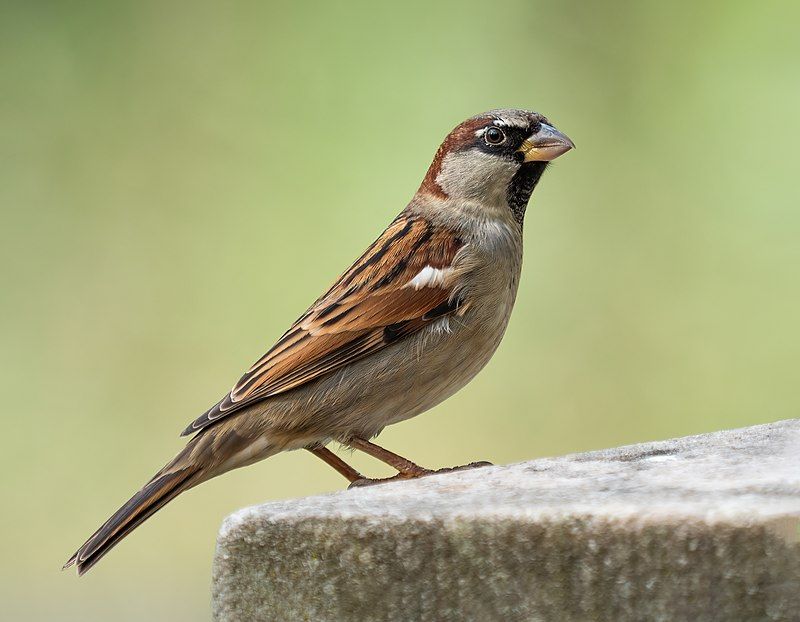
The house sparrow is a type of bird that belongs to the sparrow family called Passeridae. These birds can be found in many different parts of the world. They are pretty small, typically measuring about 16 cm in length.
In terms of weight, they usually range between 24 to 39.5 grams. Regarding their appearance, female and young house sparrows are generally colored in pale shades of brown and grey.
This coloration helps them blend in with their surroundings and provides them with some camouflage. On the other hand, male house sparrows have more vibrant colors.
They display black, white, and brown markings, making them easily distinguishable from the females and young birds.
The contrasting colors of the male house sparrows serve various purposes. Firstly, these colors help attract mates during the breeding season.
The brighter markings act as a visual signal to the females, indicating that the male is healthy and capable of providing for offspring.
These markings also play a role in defending territory and establishing dominance among other male sparrows.
The house sparrow’s coloration is not only limited to their feathers. They also have distinct beak colors that differ between males and females.
| Kingdom | Animalia |
| Phylum | Chordata |
| Clade | Dinosauria |
| Class | Aves |
| Order | Passeriformes |
| Family | Passeridae |
| Genus | Passer |
| Species | P. domesticus |
6. Red-Bellied Woodpecker
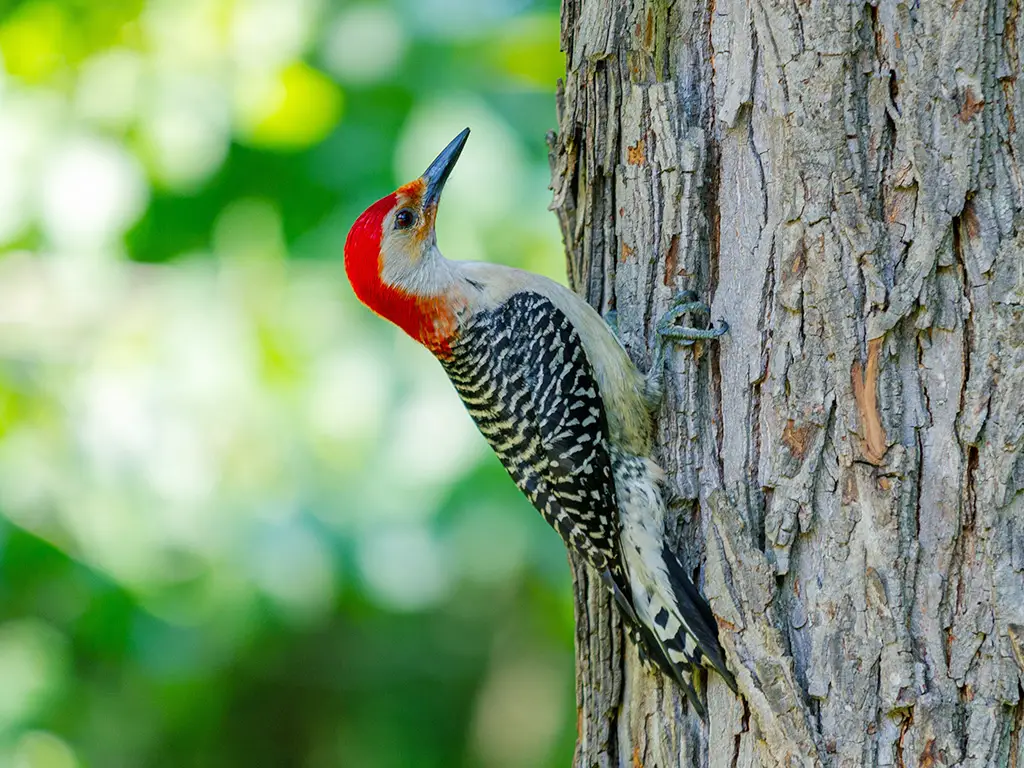
The red-bellied woodpecker is a bird that belongs to the family Picidae. It is not too big or too small; it is considered a medium-sized woodpecker.
This means it is smaller than some other woodpecker species but more significant than others. These woodpeckers are found primarily in the eastern part of the United States. However, they can also be seen in other areas.
They have a wide range, stretching from as far south as Florida to as far north as Canada. This means that they can be found in many different states and provinces within these regions. Regarding their appearance, the red-bellied woodpecker has some distinct features.
As the name suggests, they have a red belly, although this may not be immediately noticeable. Their belly is more of a pale or dull red color compared to other parts of their body.
They also have a red cap on the top of their head, which is more vibrant and noticeable. In addition to their red belly and cap, these woodpeckers have a black and white pattern on their back, wings, and tail.
The black feathers provide a nice contrast against the white feathers, creating a visual.
| Kingdom | Animalia |
| Phylum | Chordata |
| Clade | Dinosauria |
| Class | Aves |
| Order | Piciformes |
| Family | Picidae |
| Genus | Melanerpes |
| Species | M. carolinus |
7. Downy Woodpecker
The downy woodpecker is a type of bird known as a woodpecker. It is the smallest species of woodpecker found in North America. Its size can range from 14 to 18 centimeters.
These woodpeckers can be found in various forested areas across the United States and Canada.
However, they are not commonly seen in desert regions in the southwest or the northern tundra. Due to their small size, downy woodpeckers are well-adapted to living in forested environments.
They can navigate through the trees and search for food more quickly than larger woodpecker species. One exciting feature of the downy woodpecker is its ability to drum on trees.
This drumming serves multiple purposes, including communication with other woodpeckers and marking its territory. The diet of the downy woodpecker primarily consists of insects and larvae found within the trees.
They use their strong beaks to peck at the bark and wood, uncovering their prey. These woodpeckers are known for their distinct black and white plumage.
They have a white belly and back, with black wings and a black head. This coloration helps them blend in with the tree.
| Kingdom | Animalia |
| Phylum | Chordata |
| Clade | Dinosauria |
| Class | Aves |
| Order | Piciformes |
| Family | Picidae |
| Genus | Dryobates |
| Species | D. pubescens |
8. Harris’s Sparrow
The Harris’s sparrow is a type of bird that belongs to the sparrow family. It is known for being quite large compared to other sparrows. This bird has a specific breeding habitat, which is located in the northern part of central Canada.
It is the only type of bird that breeds exclusively in Canada. This makes it special and unique because it has not been found breeding anywhere else. During the winter, the Harris’s sparrow migrates to different regions in the United States.
Specifically, it travels to the Great Plains states. These states include southern South Dakota, down to central Texas. The sparrow finds these areas more suitable and comfortable during the colder months.
It is interesting to note that Harris’s sparrow has a specific migration pattern. It spends its breeding season in Canada and then travels southwards to the United States for the winter.
This pattern allows the bird to adapt to different climates and find suitable conditions for survival throughout the year. The migration of the Harris sparrow is crucial for its survival and plays a significant role in maintaining the balance of ecosystems.
By traveling to different regions, the sparrow helps in pollination.
| Kingdom | Animalia |
| Phylum | Chordata |
| Clade | Dinosauria |
| Class | Aves |
| Order | Passeriformes |
| Family | Passerellidae |
| Genus | Zonotrichia |
| Species | Z. querula |
9. Northern Flicker
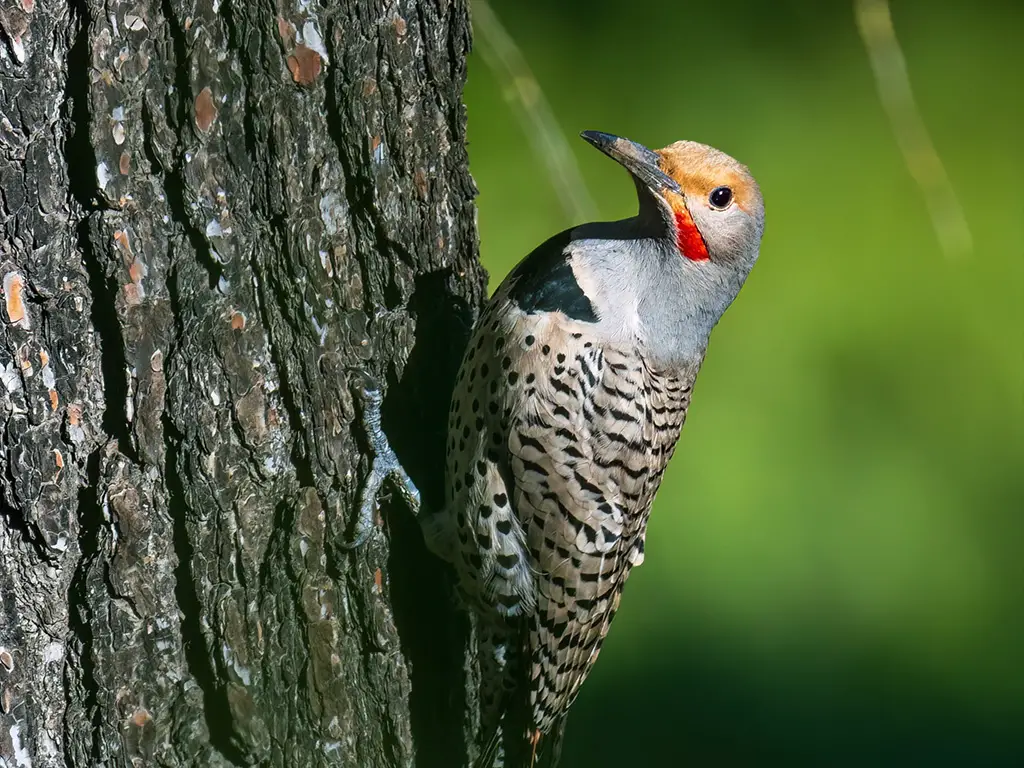
The northern flicker is a bird that belongs to the woodpecker family. It is not a very large bird but also not too small. The northern flicker can be found in many parts of North America.
It is also native to some areas in Central America, such as Cuba and the Cayman Islands. One exciting thing about the northern flicker is that it is one of the few woodpecker species that migrate.
Migration means these birds travel from one place to another during different seasons. They do this to find food and suitable habitats.
The northern flicker migrates to different regions depending on the time of year. During the breeding season, which is usually in the spring or summer, the northern flicker can be found in many parts of North America.
They build their nests in trees and use their strong beaks to create holes in the wood. These holes are called cavities and serve as their homes. Northern flickers are known for their distinctive markings.
They have a brown body with black spots, and their wings have a white patch easily visible when flying. Another unique feature is the red or yellow coloration on the underside of their wings and tail.
| Kingdom | Animalia |
| Phylum | Chordata |
| Clade | Dinosauria |
| Class | Aves |
| Order | Piciformes |
| Family | Picidae |
| Genus | Colaptes |
| Species | C. auratus |
10. Dark-Eyed Junco
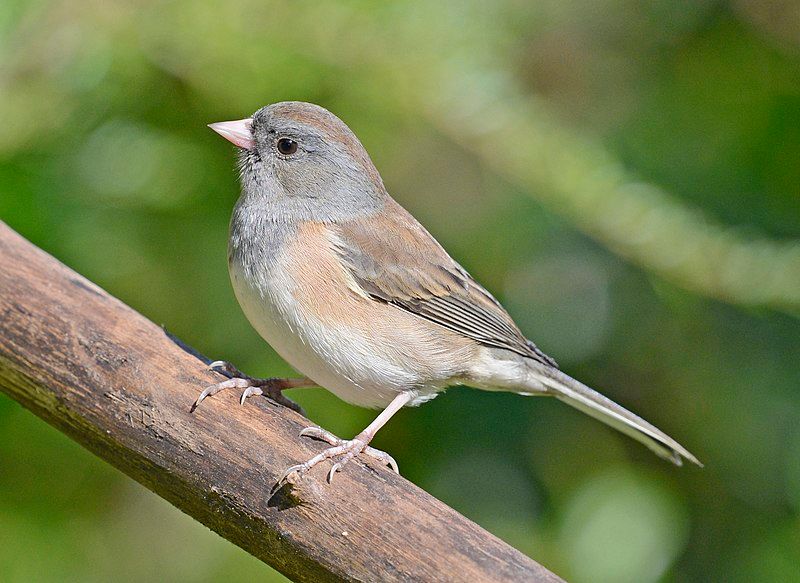
The dark-eyed junco is a type of bird called a junco. Juncos are small, grayish sparrows that live in the New World. The dark-eyed junco is found in many parts of temperate North America; during the summer, it even goes as far as the Arctic.
The dark-eyed junco is a species that has a lot of variation. This means that different individuals of this bird can look quite different from one another. It is similar to another species of sparrow called the fox sparrow in terms of its variability.
Despite being studied by scientists, the systematics of the dark-eyed junco are still not fully understood. Systematics refers to studying the relationships between different species and their classification.
So, even though researchers have been trying to figure out how the dark-eyed junco fits into the larger picture of bird species, there are still some unanswered questions.
| Kingdom | Animalia |
| Phylum | Chordata |
| Clade | Dinosauria |
| Class | Aves |
| Order | Passeriformes |
| Family | Passerellidae |
| Genus | Junco |
| Species | J. hyemalis |
11. Black-Capped Chickadee
The black-capped chickadee is a small songbird found in North America. It is known for its distinctive black cap and white cheeks.
This bird is not migratory, meaning it does not travel long distances during different seasons. The black-capped chickadee prefers to live in deciduous and mixed forests.
These types of forests provide the bird with the necessary habitat, such as trees and shrubs, where it builds its nests and finds food.
As a passerine bird, it belongs to the tit family, which is scientifically called Paridae. Interestingly, the black-capped chickadee holds special significance in certain regions.
It is the state bird of Massachusetts and Maine in the United States, symbolizing its importance to the local environment and culture.
Additionally, in Canada, specifically in the province of New Brunswick, it is recognized as the provincial bird. Overall, the black-capped chickadee is a small, nonmigratory songbird found in North America.
It thrives in deciduous and mixed forests and belongs to the tit family. Its significance is acknowledged through its designation as the state bird in Massachusetts and Maine and the provincial bird of New Brunswick.
| Kingdom | Animalia |
| Phylum | Chordata |
| Clade | Dinosauria |
| Class | Aves |
| Order | Passeriformes |
| Family | Paridae |
| Genus | Poecile |
| Species | P. atricapillus |
12. Common Starling
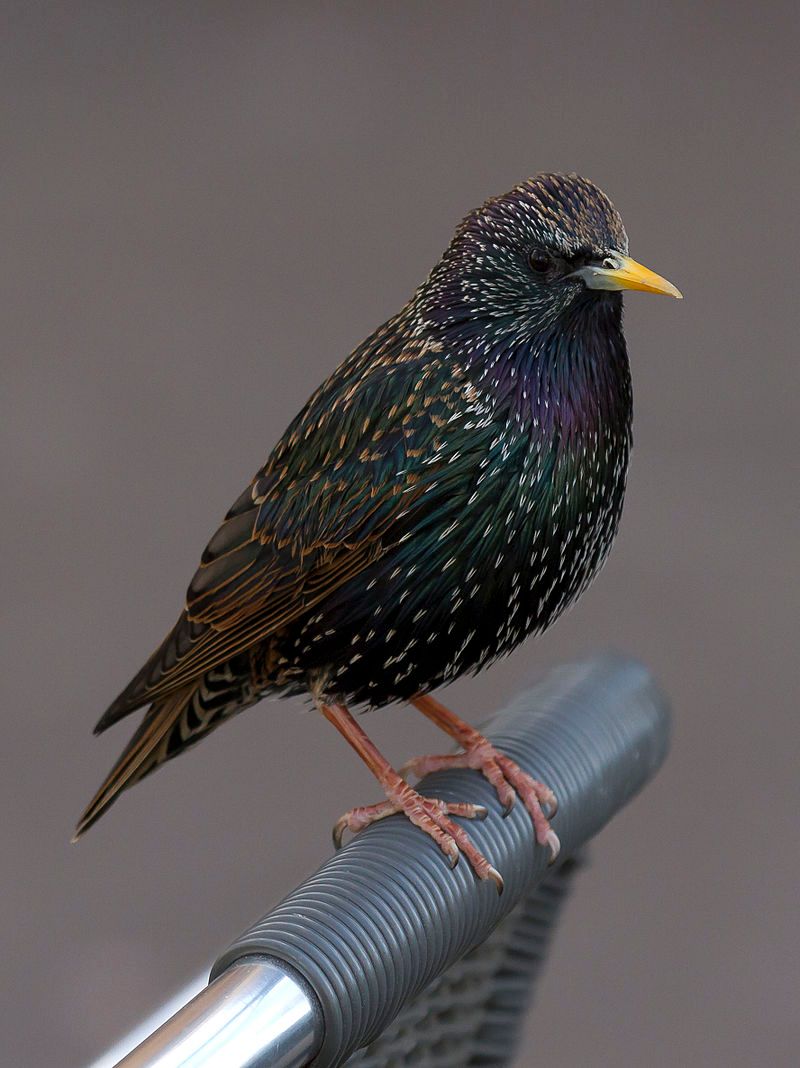
The common starling is a type of bird found in various regions. Depending on the location, it is referred to by different names. It is known as the European starling in North America, while in Great Britain and Ireland, it is simply called the starling.
This bird belongs to the starling family, scientifically known as Sturnidae. The common starling is classified as a passerine bird with its medium-sized build. Passerine birds are characterized by having feet adapted for perching, and they make up the most significant order of birds.
The starling family, to which the common starling belongs, is known for its diverse species worldwide. The common starling is known for its unique features and behaviors. It has a sleek and shiny black plumage with speckled spots, which gives it a distinct appearance.
The bird’s feathers can also appear iridescent in certain lighting conditions, showcasing shades of green and purple. One of the remarkable aspects of the common starling is its ability to mimic sounds and voices.
It has a wide range of vocalizations and can imitate various sounds in its environment, including other bird calls, human speech, and even mechanical noises.
| Kingdom | Animalia |
| Phylum | Chordata |
| Clade | Dinosauria |
| Class | Aves |
| Order | Passeriformes |
| Family | Sturnidae |
| Genus | Sturnus |
| Species | S. vulgaris |
13. American Crow
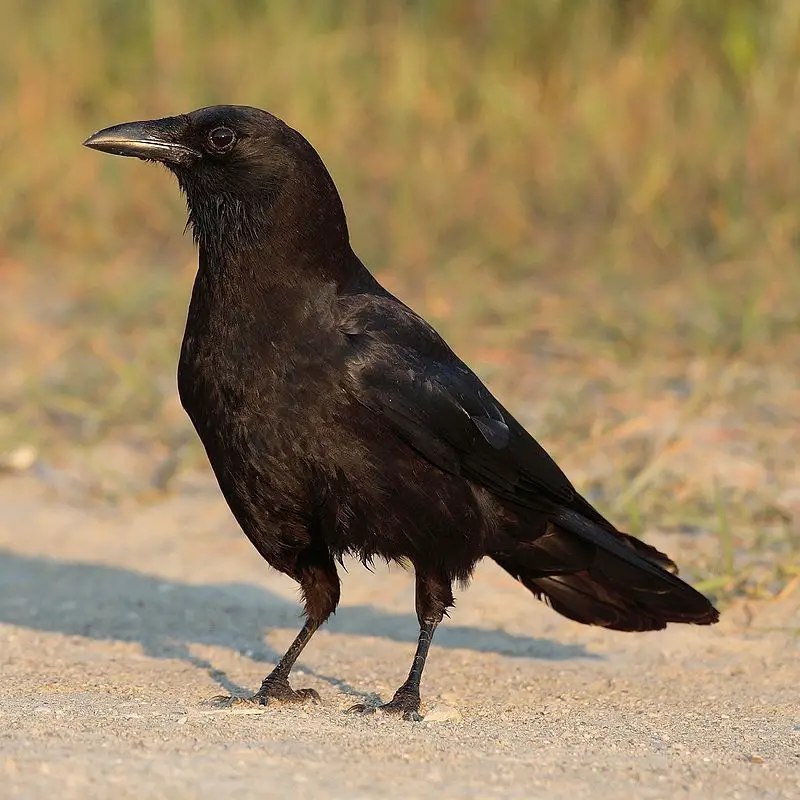
The American crow is a type of bird that belongs to the Corvidae family. This family includes other birds like ravens and jays. The American crow is quite extensive and is known as a passerine bird, meaning it has feet adapted for perching on branches.
You can find American crows in many parts of North America. They are a widespread bird so that you might have seen them in your neighborhood. They have adapted well to different environments and can be found in urban areas, forests, and open fields.
Interestingly, American crows are similar to two other crows found in different parts of the world. These are the carrion crow and the hooded crow found in Europe and Asia.
Despite being from different continents, these three crows occupy the same ecological niche. An ecological niche refers to the role a species plays in its environment. In this case, the American crow, carrion crow, and hooded crow have similar behaviors and habits.
They are opportunistic feeders, meaning they eat a wide range of things like insects, fruits, small animals, and even garbage. They also play essential roles in controlling populations of certain pests and scavenging.
| Kingdom | Animalia |
| Phylum | Chordata |
| Clade | Dinosauria |
| Class | Aves |
| Order | Passeriformes |
| Family | Corvidae |
| Genus | Corvus |
| Species | C. brachyrhynchos |
14. Mourning Dove
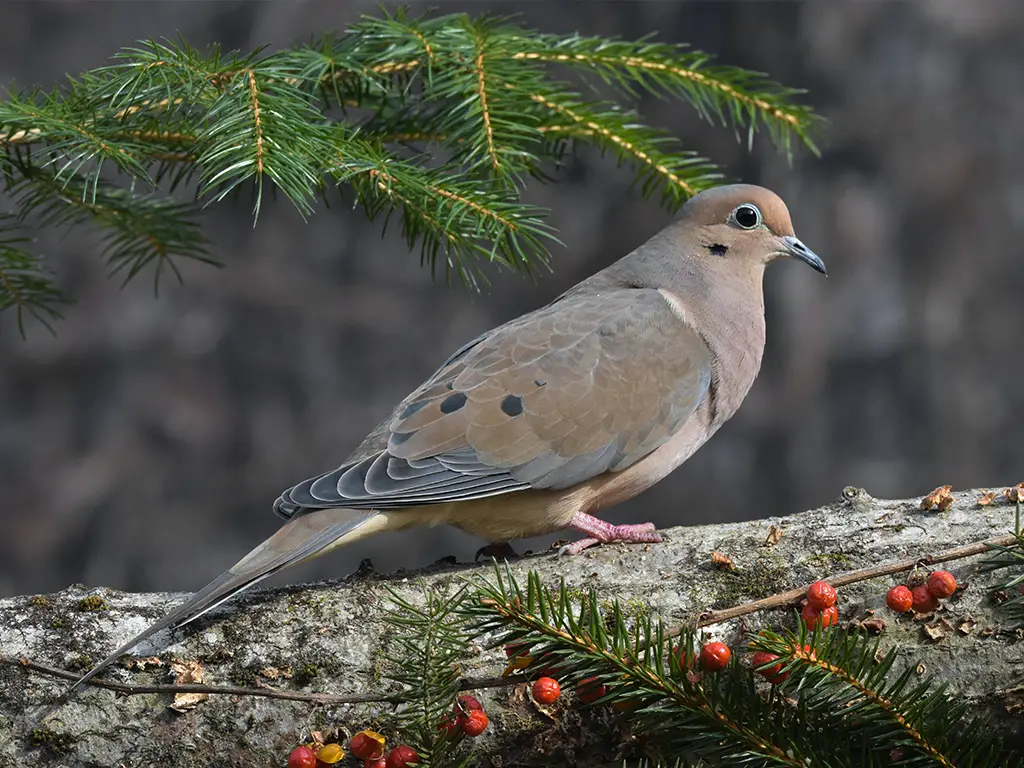
The mourning dove is a type of bird that belongs to the dove family called Columbidae. This bird is also known by different names, such as the American mourning dove, the rain dove, colloquially, the turtle dove.
In the past, it was referred to as the Carolina pigeon and Carolina turtledove. The mourning dove is a common species found in North and Central America. It is recognized for its soft, mournful cooing sound, which gives it its name.
This bird is known for its slender body and long, pointed tail. It has a grayish-brown color with lighter shades on its underparts. One interesting fact about mourning doves is their ability to adapt to various habitats.
They can be found in different environments like forests, fields, urban areas, and deserts. They are known to thrive in both rural and suburban settings. Mourning doves primarily feed on seeds, grains, and fruits.
They have a unique diet as they can swallow seeds whole and store them in their crop, a specialized part of their digestive system. This allows them to eat in one location and then retreat to a safer place to digest their food. These birds are monogamous, meaning they mate.
| Kingdom | Animalia |
| Phylum | Chordata |
| Clade | Dinosauria |
| Class | Aves |
| Order | Columbiformes |
| Family | Columbidae |
| Genus | Zenaida |
| Species | Z. macroura |
15. Yellow-Rumped Warbler
The yellow-rumped warbler is a type of bird found in North America. It is pretty common and can be seen in many different places across the continent. This bird species is known for its distinct yellow feathers on its rump or lower back.
This is where it gets its name from. These yellow feathers make it easy to identify the yellow-rumped warbler in the wild. The yellow-rumped warbler is a small bird, measuring around 5 to 6 inches in length. It has a slim body with a pointed beak and long wings.
Its wingspan can reach 9 to 10 inches, allowing it to fly swiftly and gracefully. One interesting fact about this bird is that it is known for its ability to migrate long distances. Yellow-rumped warblers can be found in North America during the breeding season.
However, they migrate south to warmer regions, such as Mexico and Central America, when winter arrives. This bird species can be found in a variety of habitats. It is often seen in forests, woodlands, and even urban areas.
It has adapted well to different environments and can thrive in deciduous and coniferous forests. The yellow-rumped warbler has a diverse.
| Kingdom | Animalia |
| Phylum | Chordata |
| Clade | Dinosauria |
| Class | Aves |
| Order | Passeriformes |
| Family | Parulidae |
| Genus | Setophaga |
| Species | S. coronata |
16. Townsend’s Solitaire
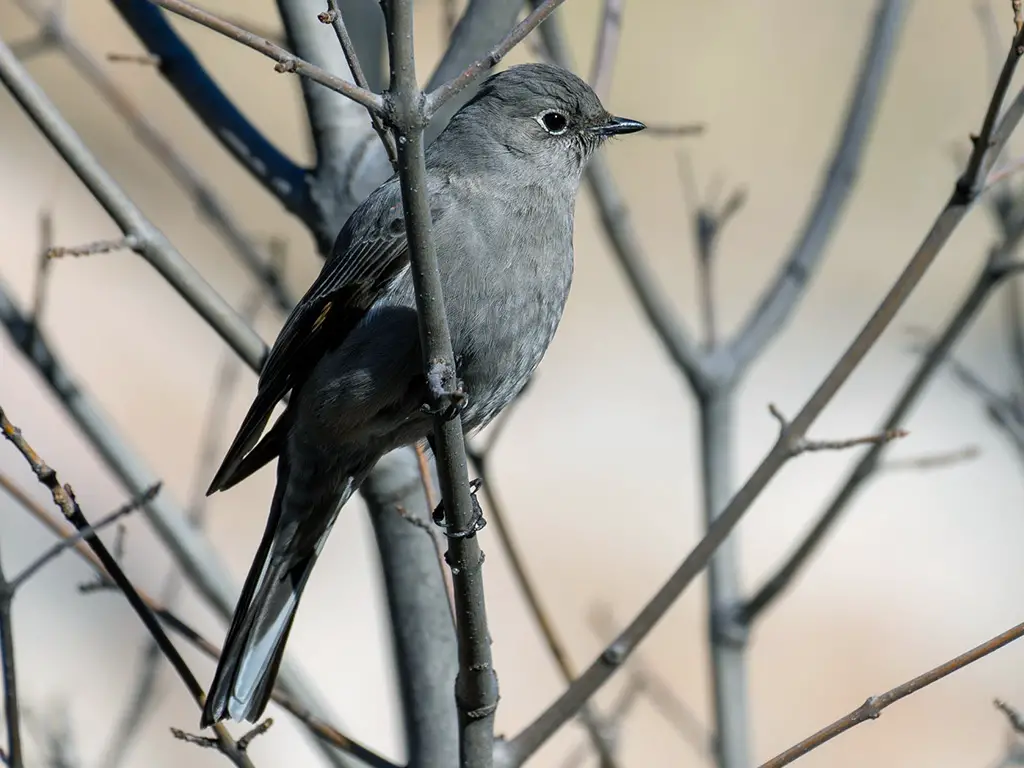
The Townsend’s solitaire is a type of bird that belongs to the thrush family. It is medium-sized, meaning it is not too big or too small.
This bird is unique because it is the only solitaire species native to North America, specifically the region above Mexico. Thrushes are a family of birds known for their melodic songs and beautiful plumage.
They are often found in wooded areas and have a diverse range of species across different parts of the world.
The Townsend’s solitaire is one such species that falls under the thrush category. Being medium-sized, Townsend’s solitaire is not as large as some other birds but also not as small as others.
It falls in between, making it easier to spot and observe in its natural habitat.
Its size allows it to navigate through trees and forage for food. What sets Townsend’s solitaire apart is that it is the only solitaire species native to North America, specifically the region above Mexico.
Solitaires are a bird known for their solitary behavior, meaning they prefer to be alone rather than in flocks or groups. This behavior is quite different from other bird species that often.
| Kingdom | Animalia |
| Phylum | Chordata |
| Clade | Dinosauria |
| Class | Aves |
| Order | Passeriformes |
| Family | Turdidae |
| Genus | Myadestes |
| Species | M. townsendi |
17. House Finch
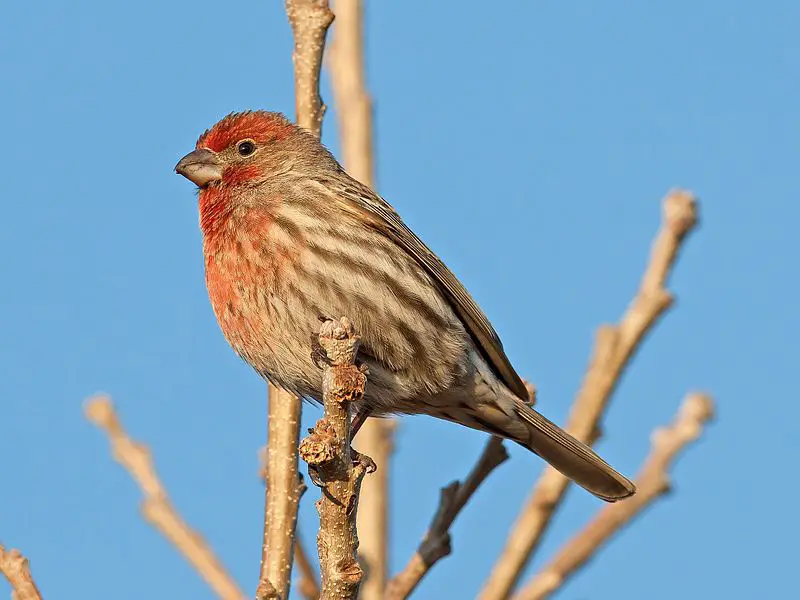
The house finch is a type of bird that belongs to the finch family called Fringillidae. This bird is originally from western North America.
However, it has also been introduced to other parts of the continent, such as the eastern half and Hawaii. The house finch is not the only bird in its genus.
It is grouped with two other American rosefinches, and all three are placed in the genus Haemorhous. The house finch is known for its beautiful red coloration, especially in males. The males have a reddish hue on their heads, chests, and backs.
Females, on the other hand, have more muted colors with brownish feathers. These birds are relatively small, measuring about 12 to 16 centimeters in length. They have short wings and a slightly notched tail.
Their beaks are conical in shape and designed for cracking open seeds, which are their primary food source. House finches are highly adaptable and can be found in various habitats, including urban areas, forests, and grasslands.
They are known for their melodic songs, which they use to communicate and attract mates. Breeding season for these.
| Kingdom | Animalia |
| Phylum | Chordata |
| Clade | Dinosauria |
| Class | Aves |
| Order | Passeriformes |
| Family | Fringillidae |
| Genus | Haemorhous |
| Species | H. mexicanus |
18. Blue Jay
The blue jay is a bird that belongs to the family Corvidae. It can be found in eastern North America. This bird is commonly found in many eastern and central United States parts.
However, it is essential to note that some blue jays in the eastern regions may migrate to other areas. In addition to the United States, blue jays reside in Newfoundland, Canada. They are considered residents in this area.
Breeding populations of blue jays can be observed across southern Canada. This means that these birds reproduce and raise their young in this region. The blue jay is a passerine bird, meaning it has specialized feet that allow it to perch on tree branches.
It is native to eastern North America and can be found in various parts of the United States, Newfoundland, and southern Canada.
| Kingdom | Animalia |
| Phylum | Chordata |
| Clade | Dinosauria |
| Class | Aves |
| Order | Passeriformes |
| Family | Corvidae |
| Genus | Cyanocitta |
| Species | C. cristata |
19. Red-Breasted Nuthatch
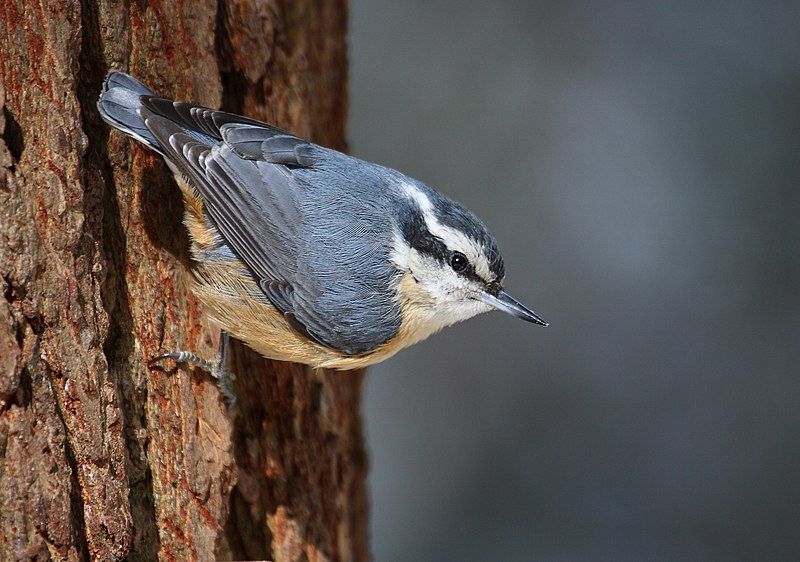
The red-breasted nuthatch is a small bird known for its beautiful appearance and unique characteristics. It has blue-grey feathers on its upper body and cinnamon-colored feathers on its underparts.
This combination of colors creates a striking contrast. Looking closely at the red-breasted nuthatch, you will notice a white throat and face. These white areas provide a stark contrast against the rest of its body.
Additionally, a distinct black stripe runs through its eyes, giving it a charming and distinctive look. Another notable feature of the red-breasted nuthatch is its straight grey bill.
This bill is perfectly shaped for its feeding habits, allowing it to crack open seeds and nuts easily easily. The bird’s bill is functional and adds to its overall appearance. One of the most striking features of the red-breasted nuthatch is its black crown.
This black area on its head gives the bird a regal and elegant look. Combined with its blue-grey and cinnamon colors, the black crown adds a touch of sophistication to its appearance. Apart from its visual characteristics, the red-breasted nuthatch has a unique call.
Described as a tin trumpet, its call is high-pitched.
| Kingdom | Animalia |
| Phylum | Chordata |
| Clade | Dinosauria |
| Class | Aves |
| Order | Passeriformes |
| Family | Sittidae |
| Genus | Sitta |
| Species | S. canadensis |
20. American Robin
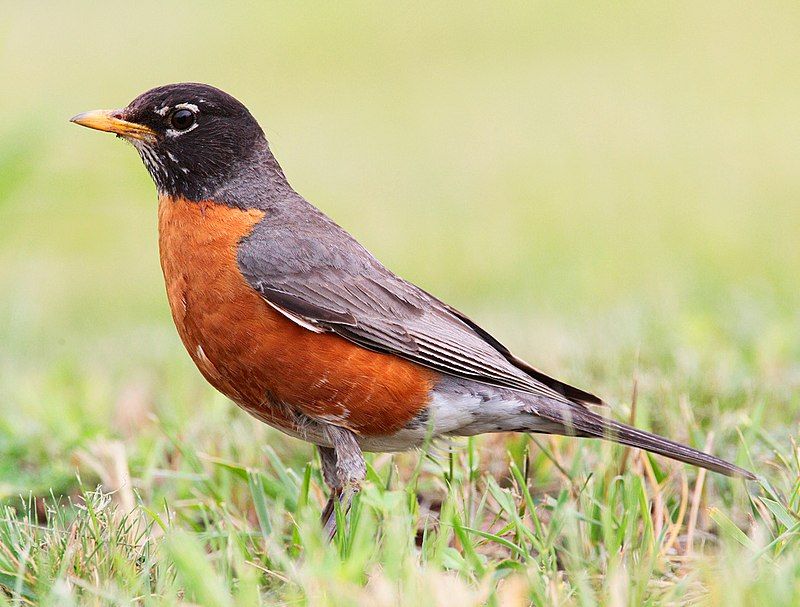
The American robin is a type of bird that migrates. It belongs to the valid thrush genus and the Turdidae family, a more prominent thrush family. It gets its name from the European robin because of its reddish-orange breast.
However, it is essential to note that the American and European robin are not closely related. The European robin is a different species and belongs to the Old World flycatcher family.
Despite their similar names and physical characteristics, these two birds are not closely related regarding their genetic makeup.
They may share some similarities in appearance, such as the reddish-orange breast, but their evolutionary paths have taken them in different directions. The American robin is primarily found in North America, while the European robin is native to Europe and parts of Asia.
Both species have adapted to their respective environments and habitats over time.
The American robin is known for its ability to migrate long distances, often traveling south during winter and returning north for breeding season. Regarding physical characteristics, the American robin is larger than the European robin.
It has a grayish-brown back and a distinct reddish-orange breast, a defining feature of the species.
| Kingdom | Animalia |
| Phylum | Chordata |
| Clade | Dinosauria |
| Class | Aves |
| Order | Passeriformes |
| Family | Turdidae |
| Genus | Turdus |
| Species | T. migratorius |
21. Eurasian Collared Dove
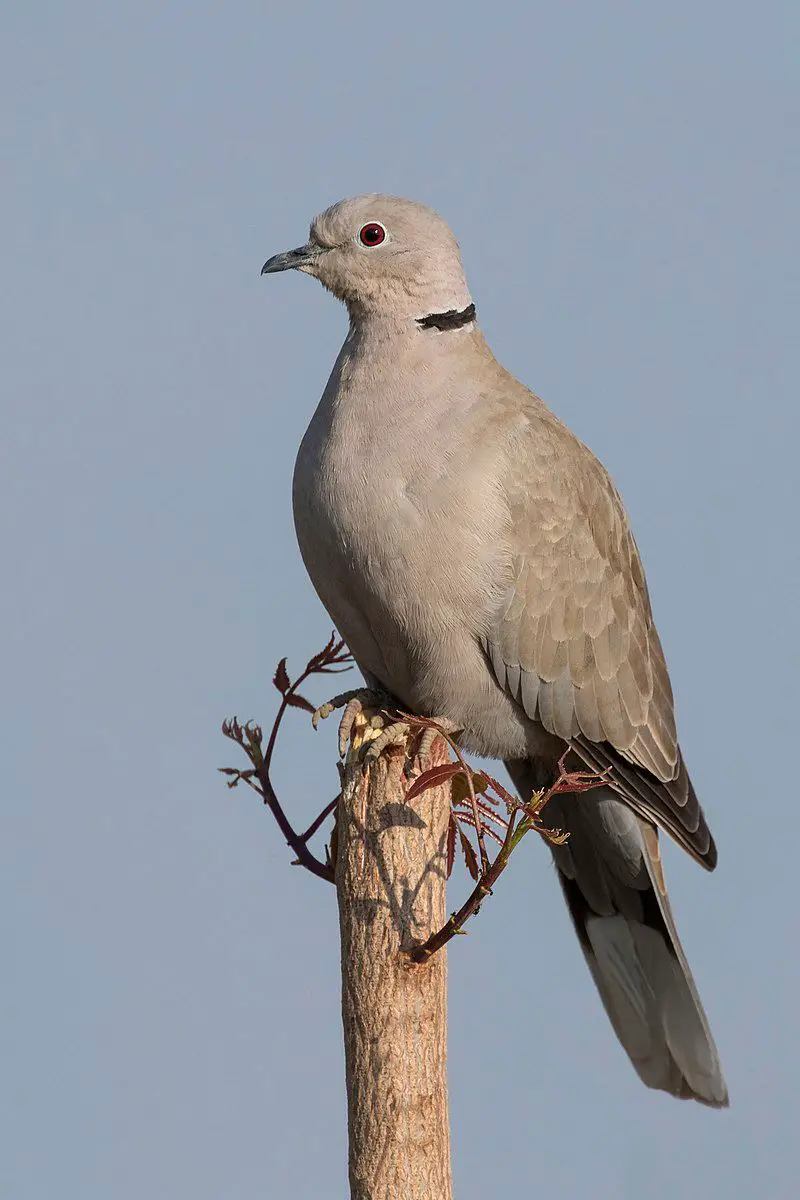
The Eurasian collared dove is a type of bird. It is naturally found in parts of Europe and Asia. However, people have brought this dove species to other places as well.
Japan, North America, and some islands in the Caribbean have now become home to the Eurasian collared dove. Initially, the Eurasian collared dove lived only in Europe and Asia. These areas were its natural habitat.
But at some point, humans decided to introduce this bird species to other parts of the world. They wanted to see if the dove could survive and thrive in new environments—one of the places where the Eurasian collared dove was introduced in Japan.
People brought these doves to Japan, which is located in East Asia.
It is interesting to think about how the doves might have adapted to Japan’s different climate and surroundings compared to their original habitat—another place where the Eurasian collared dove was introduced in North America.
With its diverse landscapes, this vast continent became a new home for these doves.
It would be fascinating to study how the doves have spread across North America and found their niche in different regions. Apart from Japan and North America, the Eurasian collared dove was also brought to islands.
| Kingdom | Animalia |
| Phylum | Chordata |
| Clade | Dinosauria |
| Class | Aves |
| Order | Columbiformes |
| Family | Columbidae |
| Genus | Streptopelia |
| Species | S. decaocto |
22. Red-Tailed Hawk
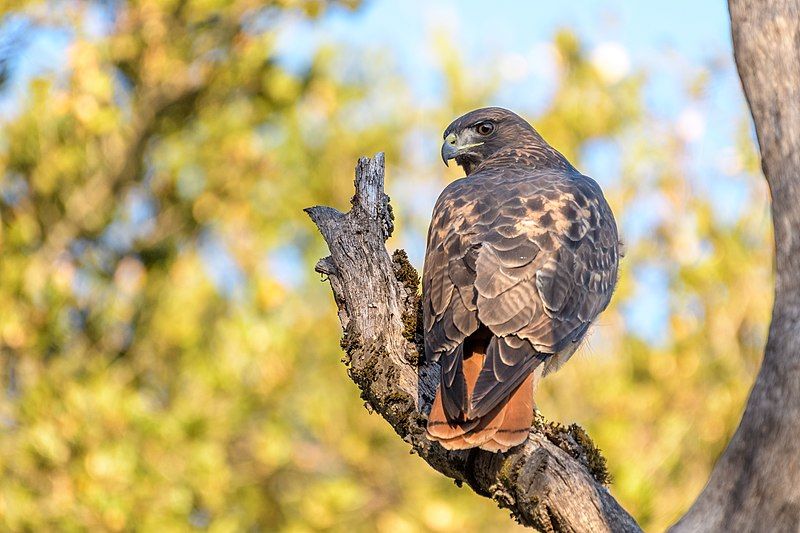
The red-tailed hawk is a type of bird known as a bird of prey. It is found in many different parts of North America. It breeds in a wide range of locations, from the interior of Alaska and northern Canada down to Panama and the West Indies.
This means you can find red-tailed hawks in many places throughout North America. The red-tailed hawk belongs to a group of birds called the genus Buteo. This genus includes many other species of hawks.
However, the red-tailed hawk is one of the most common members of this group, both in North America and worldwide.
This means that you will likely come across a red-tailed hawk more often than other types of hawks within the Buteo genus. The red-tailed hawk is known for its distinctive red tail, which is where it gets its name from.
This feature helps to distinguish it from other types of hawks. However, it is essential to note that not all red-tailed hawks have red tails.
Juvenile red-tailed hawks have brown tails, which only turn red as they mature. Red-tailed hawks are known for their impressive hunting skills. As birds of prey, they primarily.
| Kingdom | Animalia |
| Phylum | Chordata |
| Clade | Dinosauria |
| Class | Aves |
| Order | Accipitriformes |
| Family | Accipitridae |
| Genus | Buteo |
| Species | B. jamaicensis |
23. Canada Goose
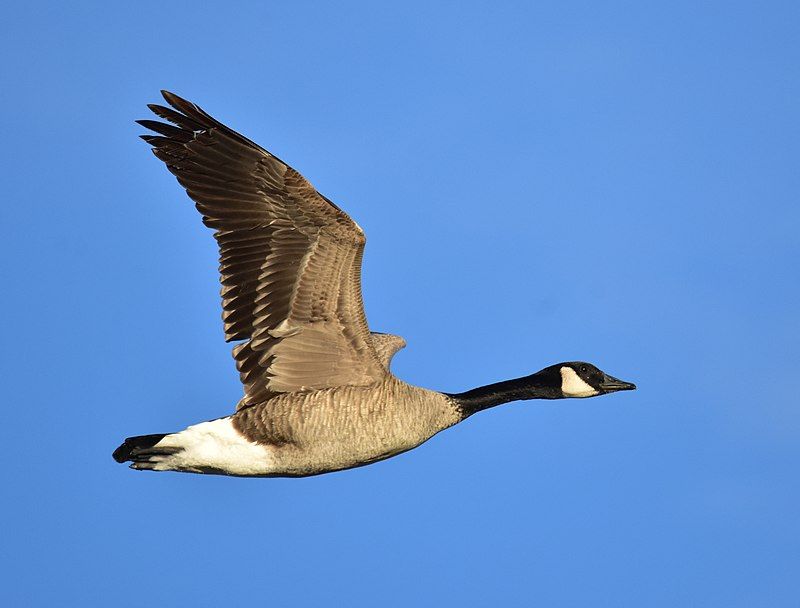
The Canada goose is a type of wild goose that can also be called the Canadian goose. It is pretty large and has distinct physical features. One of its notable characteristics is a black head and neck.
Additionally, it has white cheeks and a white area under its chin. The body of the Canada goose is typically brown. This goose species is originally from the arctic and temperate regions of North America. It is well-adapted to these colder climates.
However, during migration, the Canada goose has been known to travel across the Atlantic and can occasionally be found in northern Europe. The Canada goose is a fascinating bird that has captured the attention of many due to its unique appearance.
Its black head and neck contrast sharply against its white cheeks and chin.
This distinctive coloration helps to identify the Canada goose from other species easily. Native to North America’s arctic and temperate regions, the Canada goose has evolved to survive in harsh environments.
Its adaptations to cold climates include a sturdy build and insulating feathers.
These features enable the goose to endure freezing temperatures and harsh weather conditions. Although primarily found in North America, the Canada goose displays an exciting behavior during migration.
| Kingdom | Animalia |
| Phylum | Chordata |
| Clade | Dinosauria |
| Class | Aves |
| Order | Anseriformes |
| Family | Anatidae |
| Genus | Branta |
| Species | B. canadensis |
24. Barn Swallow
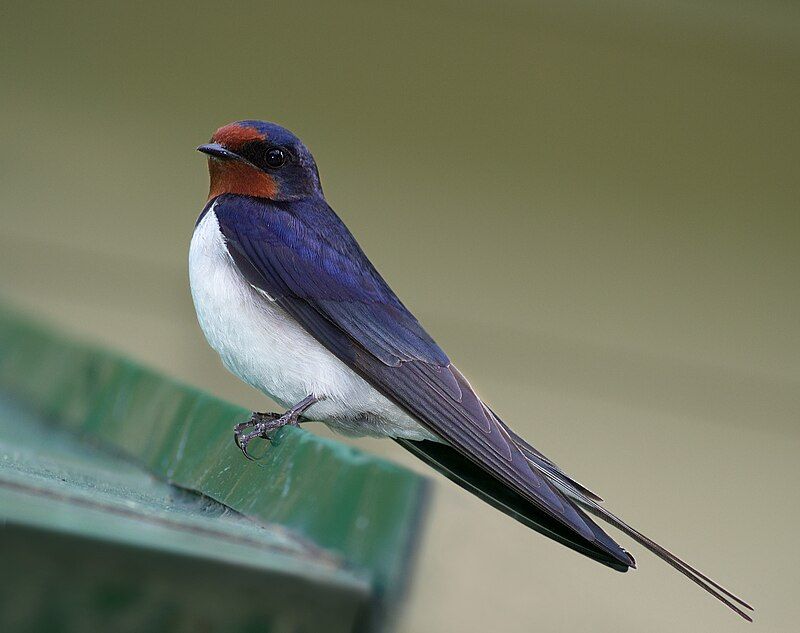
The barn swallow is a type of bird that can be found worldwide. It is the most common species of swallow.
This means there are more barn swallows than any other type of swallow in the world. What is interesting about the barn swallow is that it can be found in many different places. It has the most extensive natural distribution of any passerine bird.
Passerine birds are a type of bird that includes sparrows, finches, and swallows. This means the barn swallow can be found in more areas than any other type of passerine bird. The barn swallow’s range covers over 251 million square kilometers worldwide.
That is a vast area! To put it into perspective, that’s about the same size as the entire continent of Europe.
So, no matter where you go, there is a good chance that you will spot a barn swallow. The barn swallow is easily recognizable due to its distinctive appearance. It has blue upperparts, which means that its back and wings are blue.
This blue color is quite vibrant and stands out against the sky. It also has a long, deeply forked tail. This means that its tail is split into two distinct points.
| Kingdom | Animalia |
| Phylum | Chordata |
| Clade | Dinosauria |
| Class | Aves |
| Order | Passeriformes |
| Family | Hirundinidae |
| Genus | Hirundo |
| Species | H. rustica |
25. Cardinalidae
Cardinalidae is a family of birds found only in the New World. This means that they are native to the Americas and are not found anywhere else in the world. The family comprises different species, including cardinals, grosbeaks, and buntings.
These birds are all part of the same family because they share similar characteristics and traits. Cardinals are perhaps the most well-known members of the Cardinalidae family. They are known for their vibrant red plumage, which is more prominent in the males than females.
Cardinals are often seen in backyards and gardens, feeding on seeds and insects. They have a distinct crest on their heads, which adds to their unique appearance. Grosbeaks are another type of bird that belongs to the Cardinalidae family.
They are named after their large, thick beaks, adapted for cracking open seeds and nuts. Grosbeaks come in various colors, including red, black, and yellow.
They are known for their beautiful songs and can be found in forests and woodlands across the Americas. Buntings are also part of the Cardinalidae family. They are small to medium-sized birds that are known for their colorful plumage.
| Kingdom | Animalia |
| Phylum | Chordata |
| Clade | Dinosauria |
| Class | Aves |
| Order | Passeriformes |
| Family | Cardinalidae |
26. American Kestrel
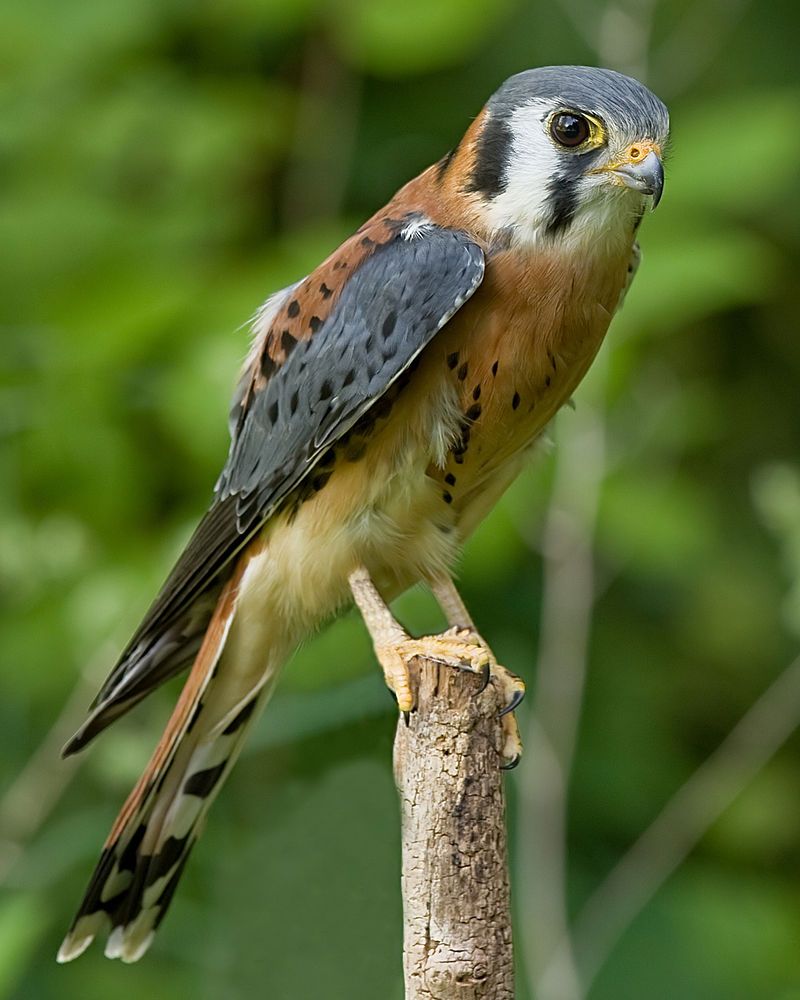
The American kestrel is a type of falcon that can also be known as the sparrow hawk. It is found in North America and is the region’s smallest and most common falcon. The size of the American kestrel can vary depending on the subspecies and the sex of the bird.
Generally, there is a two-to-one range in size between different individuals. When it comes to size, the American kestrel can range from being as small as a blue jay to as large as a mourning dove.
This means some individuals can weigh as much as a blue jay, while others can be as heavy as a mourning dove. The variation in size within the American kestrel population can be attributed to differences in subspecies and between males and females.
This means that females may generally be more significant than males, and different subspecies may have different average sizes. Interestingly, despite this size variation, the American kestrel remains the smallest falcon in North America.
This indicates that even the most prominent individuals of this species are still relatively small compared to other falcons found in the region. In conclusion, the American kestrel is also known as the sparrow.
| Kingdom | Animalia |
| Phylum | Chordata |
| Clade | Dinosauria |
| Class | Aves |
| Order | Falconiformes |
| Family | Falconidae |
| Genus | Falco |
| Species | F. sparverius |
27. Black-And-White Warbler
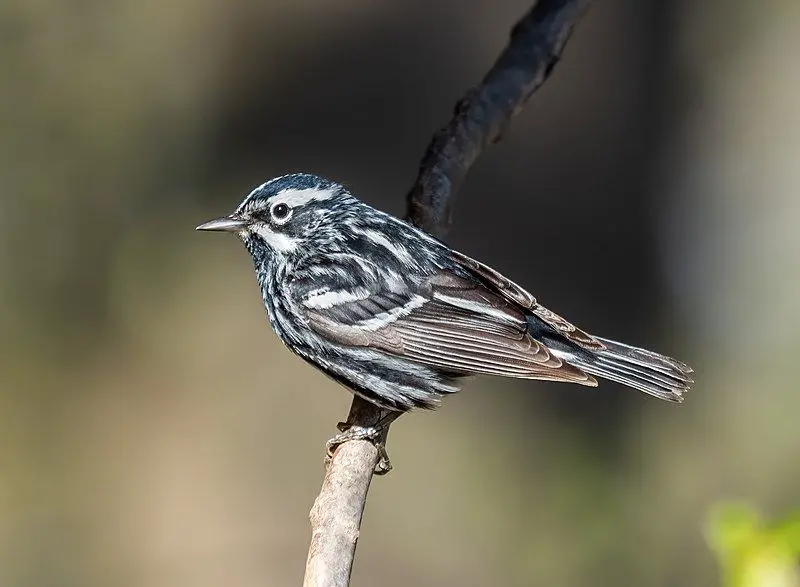
The black-and-white warbler is a type of bird that belongs to the New World warbler family. It is the only member of its genus, known as Mniotilta.
This species is mainly found in northern and eastern parts of North America. During the breeding season, the black-and-white warbler can be seen in regions of northern and eastern North America. It chooses these areas to build nests and raise its young.
However, during the winter months, this bird migrates to warmer regions. The black-and-white warbler spends its winters in Florida, Central America, and the West Indies.
These locations provide a more suitable climate and ample food sources for the birds during the colder months.
The bird’s migration journey can be pretty long as it travels from its breeding grounds in North America to these wintering areas. Interestingly, the black-and-white warbler has also been wintering as far south as Peru.
This indicates that some individuals of this species undertake even longer migrations, as Peru is quite far from its breeding grounds. While the black-and-white warbler is generally found in North and Central America, it is considered a rare vagrant in Western Europe.
| Kingdom | Animalia |
| Phylum | Chordata |
| Clade | Dinosauria |
| Class | Aves |
| Order | Passeriformes |
| Family | Parulidae |
| Genus | Mniotilta |
| Species | M. varia |
28. Great Horned Owl
The great horned owl is a species of owl found in the Americas. It is also known by other names, such as the tiger owl and the hoot owl.
This owl is known for its adaptability and can be found in various habitats across its wide range. Being a large owl, the great horned owl has a distinct appearance. It has prominent ear tufts on its head, which give it a horned appearance.
This characteristic distinguishes it from other owl species. One of the remarkable traits of the great horned owl is its adaptability. It can be found in many habitats, including forests, deserts, mountains, and even urban areas.
This versatility allows the owl to thrive in diverse environments, making it the most widely distributed true owl in the Americas. The great horned owl is a skilled hunter, preying on various animals. Its diet includes small mammals like rabbits, mice, and rats.
Additionally, it feeds on birds, reptiles, amphibians, and even other owls. This owl species has excellent hunting abilities. It possesses sharp talons and a powerful beak, which it uses to catch and kill its prey.
Its wings are designed for silent flight, allowing it to approach.
| Kingdom | Animalia |
| Phylum | Chordata |
| Clade | Dinosauria |
| Class | Aves |
| Order | Strigiformes |
| Family | Strigidae |
| Genus | Bubo |
| Species | B. virginianus |
29. Common Goldeneye
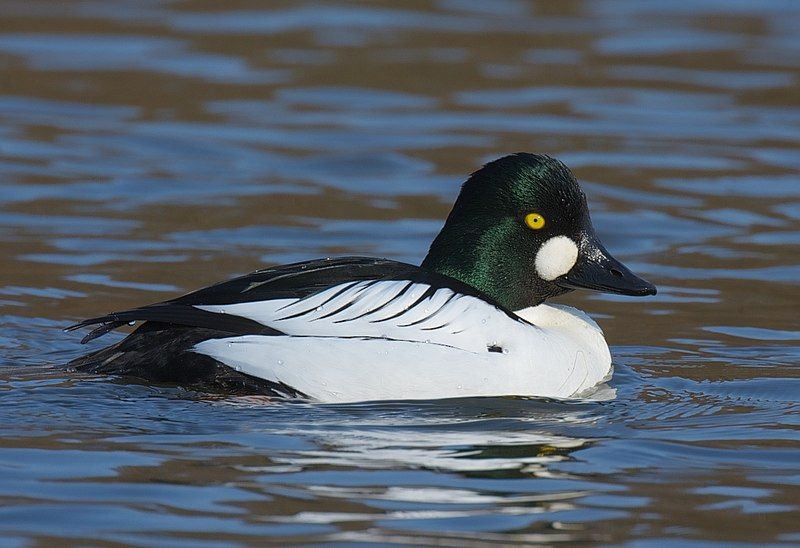
The common goldeneye, also known as goldeneye, is a type of sea duck. It is not too big, but also not too small in size. This particular duck belongs to the genus Bucephala, which includes other types of goldeneyes.
One of its closest relatives is the Barrow’s goldeneye, which is similar in appearance and characteristics. The genus name “Bucephala” has an interesting origin. It is derived from the Ancient Greek word “boukephalos,” which refers to the shape of the duck’s head.
The head of a goldeneye has a distinctive round shape, resembling a bulbous form. This is similar to the head shape of another duck species called the bufflehead, hence the reference. The common goldeneye is typically found in marine environments.
It prefers to inhabit coastal areas and spends most of its time near the sea. This sea duck has adapted well to its habitat and has developed specific characteristics to thrive. The goldeneye has a unique and attractive appearance.
Its plumage is predominantly black, with a white circular patch on its face. This patch is located just behind the eye, giving the duck a distinct look. The male and female are golden.
| Kingdom | Animalia |
| Phylum | Chordata |
| Clade | Dinosauria |
| Class | Aves |
| Order | Anseriformes |
| Family | Anatidae |
| Genus | Bucephala |
| Species | B. clangula |
30. Pileated Woodpecker
The pileated woodpecker is a type of bird that is primarily black and is found in North America. It is a relatively large bird compared to other woodpeckers. The pileated woodpecker mostly eats insects, which makes it an insectivore.
It usually lives in deciduous forests located in eastern North America. In addition to the east part of North America, the pileated woodpecker can also be found in the Great Lakes region. This means it can be seen in Michigan, Minnesota, and the surrounding states.
The bird is also found in the boreal forests of Canada. These forests are characterized by primarily coniferous trees and are located in northern Canada. Furthermore, the pileated woodpecker can be spotted in certain areas along the Pacific Coast.
This means it can be found in states like Oregon and Washington. It is interesting to note that the bird’s habitat spans different regions, showing its adaptability to various environments.
Overall, the pileated woodpecker is a fascinating bird native to North America. Its black feathers and relatively large size make it easy to identify. It prefers to live in deciduous forests.
| Kingdom | Animalia |
| Phylum | Chordata |
| Clade | Dinosauria |
| Class | Aves |
| Order | Piciformes |
| Family | Picidae |
| Genus | Dryocopus |
| Species | D. pileatus |
31. Winter Wren
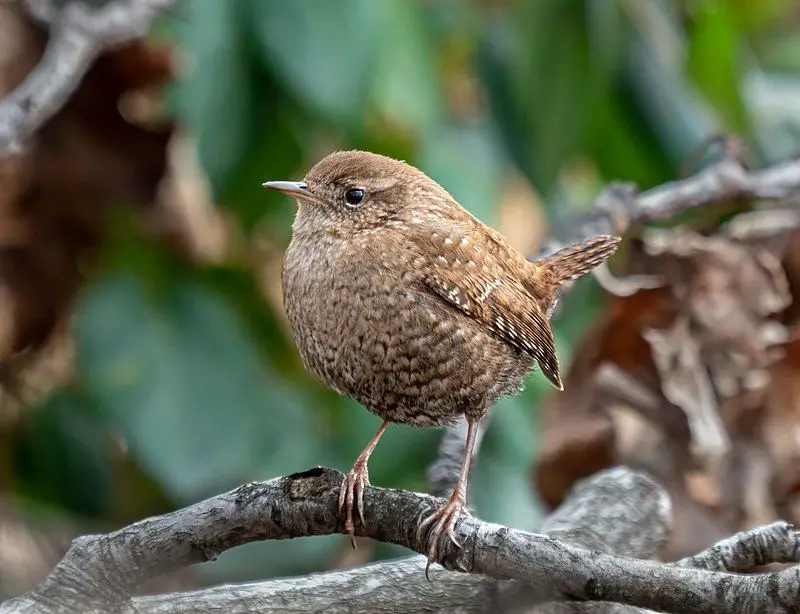
The winter wren is a tiny bird found in North America. It belongs to the Troglodytidae family, mainly consisting of wrens in the New World.
In the past, it was considered the same species as the Pacific wren in western North America and the Eurasian wren in Eurasia.
However, it is now recognized as a distinct species called the winter wren. The winter wren is known for its small size and is one of the smallest birds in North America.
It can be found in coniferous forests, dominated by cone-bearing trees like pine, spruce, and fir. Its habitat ranges from British Columbia in Canada to the Atlantic Ocean. This little bird is known for its distinctive behavior and appearance.
It has a compact body with short wings and a short tail, making it well-suited for navigating through dense forest vegetation.
Its plumage is usually dark brown with fine streaks on its back and a light-colored throat and belly. During the breeding season, which generally occurs in the spring and summer, the winter wren builds its nest in tree cavities or among tree roots.
The male wren is known for its beautiful and melodious song.
| Kingdom | Animalia |
| Phylum | Chordata |
| Clade | Dinosauria |
| Class | Aves |
| Order | Passeriformes |
| Family | Troglodytidae |
| Genus | Troglodytes |
| Species | T. hiemalis |
32. Red-Headed Woodpecker
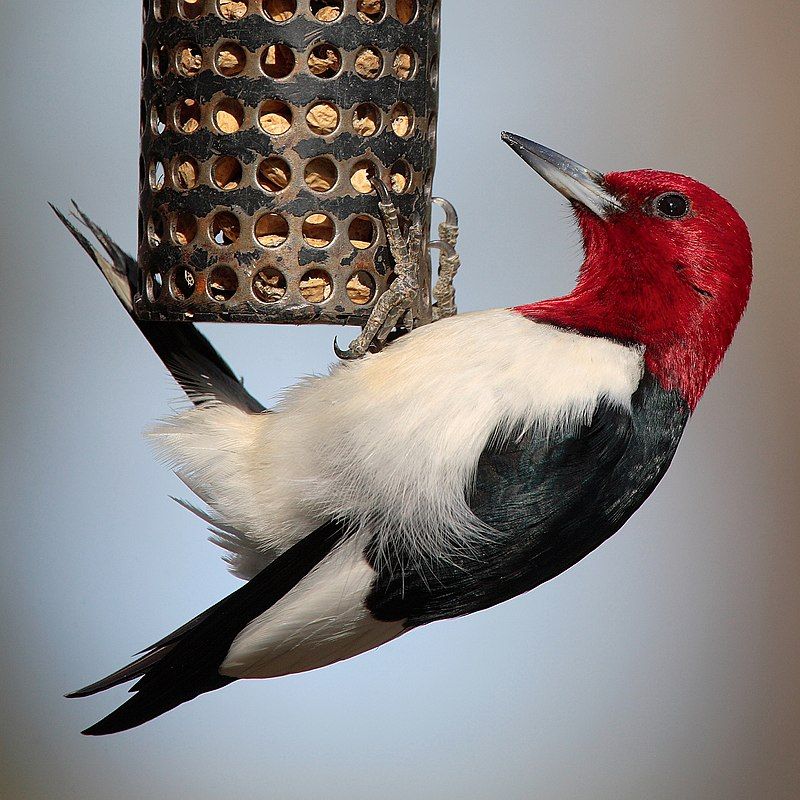
The red-headed woodpecker is a type of woodpecker found in temperate regions of North America. It is not too big or too small, but rather a mid-sized bird. This woodpecker is known for its distinct red head, which sets it apart from other species.
Its vibrant red color stands out against its black and white body. Regarding its habitat, the red-headed woodpecker prefers open areas in southern Canada and the east-central United States. It is specifically found in regions with a moderate climate.
This woodpecker builds its nests during the breeding season in these open country habitats. It looks for suitable spots to create its nest, often choosing dead trees or branches.
The red-headed woodpecker is a skilled excavator, using its strong beak to make holes in the trees for its nests. These holes not only serve as a nesting site but also as a source of food storage.
In addition to nesting, the red-headed woodpecker also searches for food in its breeding habitat. It feeds on various insects, fruits, nuts, and even small vertebrates. This woodpecker is known for its agility and acrobatics.
| Kingdom | Animalia |
| Phylum | Chordata |
| Clade | Dinosauria |
| Class | Aves |
| Order | Piciformes |
| Family | Picidae |
| Genus | Melanerpes |
| Species | M. erythrocephalus |
33. Red-Winged Blackbird
The red-winged blackbird is a type of bird that belongs to the passerine family called Icteridae.
It is commonly found in various parts of North America and a significant portion of Central America. Passerines are a diverse group of birds known for their musical and complex songs.
They have specialized vocal organs that produce a wide range of sounds. The red-winged blackbird is easily recognizable due to its distinct appearance.
The male red-winged blackbird has glossy black plumage and bright red patches on its wings, which give it its name.
On the other hand, the female red-winged blackbird has a more subdued appearance with brown feathers and streaks. These birds have a unique habitat preference, as they are commonly found in wetlands, marshes, and areas with tall grasses.
They are skilled at perching on tall plants and reeds, where they can easily spot their prey and potential predators. Red-winged blackbirds primarily feed on insects, seeds, and grains. They use their sharp beaks to catch insects on the fly and extract seeds from plants.
During the breeding season, they may consume small vertebrates such as frogs and tadpoles.
| Kingdom | Animalia |
| Phylum | Chordata |
| Clade | Dinosauria |
| Class | Aves |
| Order | Passeriformes |
| Family | Icteridae |
| Genus | Agelaius |
| Species | A. phoeniceus |
34. Blue Grosbeak
The blue grosbeak is a type of bird found in North America. It belongs to the cardinal family known as Cardinalidae. This bird is of medium size, neither too small nor too large.
The blue grosbeak is a migratory bird, which travels from one place to another during different seasons. It spends the winter months in Central America, where the climate is warmer.
However, it moves to northern Mexico and the southern United States during the breeding season. The male blue grosbeak is particularly fascinating. It is adorned with a beautiful blue plumage, which gives it its name. The blue color is vibrant and eye-catching.
Along with its blue feathers, the male has two brown wing bars. These bars are markings on its wings that are brown.
These bars help in distinguishing the bird and add to its overall appearance. On the other hand, the female blue grosbeak has different characteristics.
She doesn’t possess the same vibrant blue color as the male. Instead, her plumage is a mix of brown and gray tones. This difference in appearance between the male and female blue grosbeak is known as sexual dimorphism.
| Kingdom | Animalia |
| Phylum | Chordata |
| Clade | Dinosauria |
| Class | Aves |
| Order | Passeriformes |
| Family | Cardinalidae |
| Genus | Passerina |
| Species | P. caerulea |
35. Barred Owl
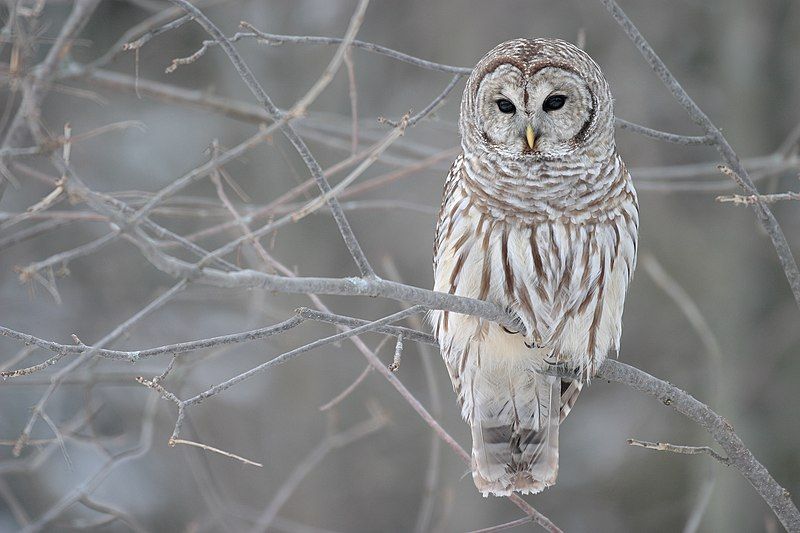
The barred owl is a type of owl found in North America. It is sometimes called the northern barred owl, striped owl, hoot owl, or eight-hooter owl.
This owl is quite large compared to other owls. It belongs to a family of owls called Strigidae, known as true owls. The barred owl belongs explicitly to the genus Strix.
The name of the family, Strigidae, comes from the genus Strix. Linnaean taxonomy is a system of naming and classifying organisms that Carl Linnaeus, a Swedish botanist, created.
This system organizes living organisms into different categories based on their characteristics. The barred owl’s scientific name is Strix varia.The genus name comes first in Linnaean taxonomy, followed by the species name.
So, for the barred owl, Strix is the genus, and varia is the species.
This helps scientists and researchers identify and study different species. The barred owl is known for its distinctive call, which sounds like “who-cooks-for-you, who-cooks-for-you-all.” This call is often heard at night, so it is sometimes called a hoot owl.
| Kingdom | Animalia |
| Phylum | Chordata |
| Clade | Dinosauria |
| Class | Aves |
| Order | Strigiformes |
| Family | Strigidae |
| Genus | Strix |
| Species | S. varia |
36. Baltimore Oriole
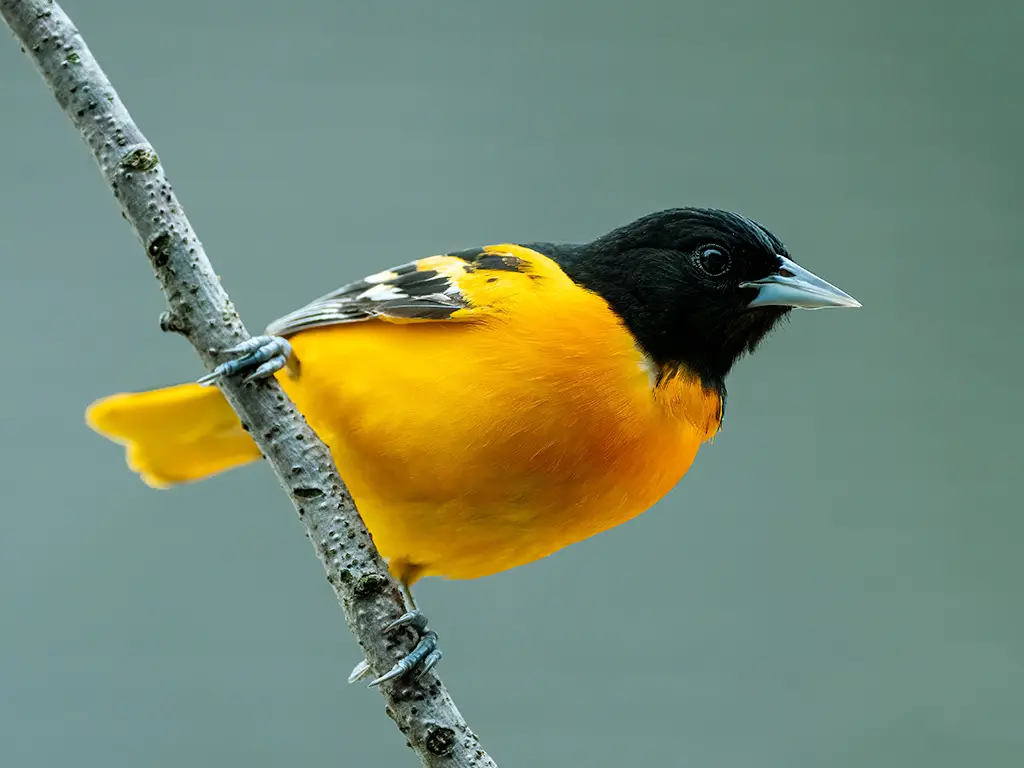
The Baltimore oriole is a bird that belongs to the icterid blackbird family. It is found commonly in eastern parts of North America. This bird is known for its tendency to migrate during the breeding season. The reason behind its name is quite fascinating.
It is said that the Baltimore oriole got its name because of the similarity between the male’s colors and the coat-of-arms of Lord Baltimore, who lived in the 17th century.
This suggests the bird’s vibrant and distinct colors reminded people of the coat of arms. The male Baltimore oriole is mainly known for its striking appearance. It has bright orange plumage on its underparts, while its head, back, and wings are black.
These contrasting colors make the male Baltimore oriole stand out in its habitat. On the other hand, the female Baltimore oriole has a more subdued appearance. Its plumage is primarily yellowish-brown, which helps it blend in better with its surroundings.
This difference in appearance between males and females is a common characteristic among many bird species. In addition to its striking appearance, the Baltimore oriole is known for its beautiful song. The male bird sings a complex.
| Kingdom | Animalia |
| Phylum | Chordata |
| Clade | Dinosauria |
| Class | Aves |
| Order | Passeriformes |
| Family | Icteridae |
| Genus | Icterus |
| Species | I. galbula |
37. Common Grackle
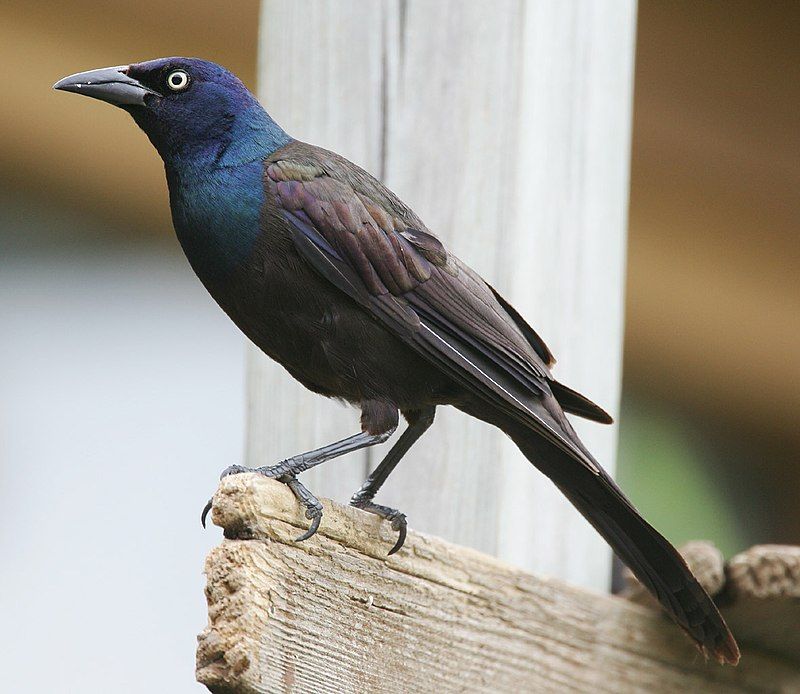
The common grackle is a type of bird found in many parts of North America. It was first identified and described by a scientist named Carl Linnaeus in 1758. This bird belongs to a family of birds known as icterids.
One exciting thing about the common grackle is that it has three different subspecies. This means there are slight variations in appearance among the various groups of these birds. When an adult common grackle is fully grown, it has certain distinct features.
For example, it has a long bill that is dark in color. The bird uses this bill to catch and eat its food. The common grackle also has pale yellow eyes, which add to its unique appearance. Another noticeable characteristic of the adult common grackle is its long tail.
This tail is an essential part of the bird’s body, as it helps with balance and maneuverability during flight. It is worth noting that the common grackle is a reasonably large bird compared to some other species.
Its size contributes to its visibility and makes it easier to spot in its natural habitat. The common grackle is an exciting bird species with distinct physical traits. It’s large numbers across the North.
| Kingdom | Animalia |
| Phylum | Chordata |
| Clade | Dinosauria |
| Class | Aves |
| Order | Passeriformes |
| Family | Icteridae |
| Genus | Quiscalus |
| Species | Q. quiscula |
38. American Wigeon
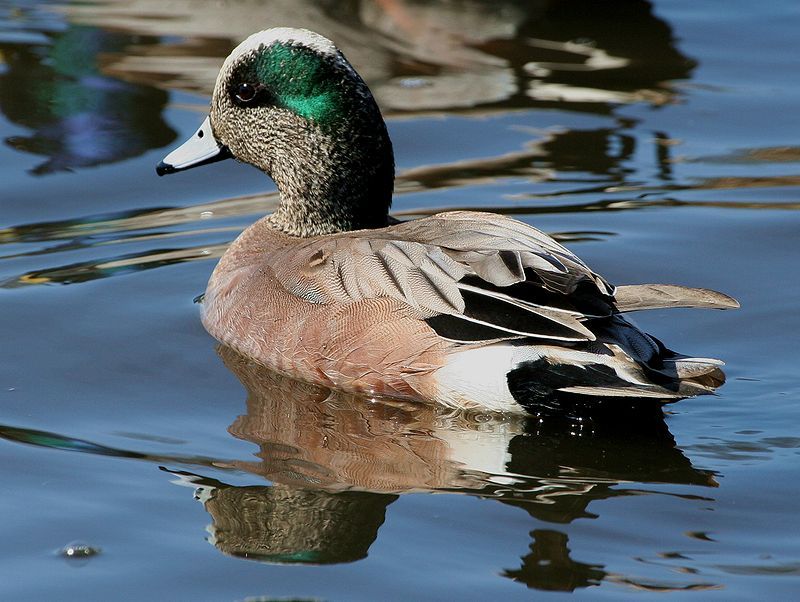
The American wigeon is a type of duck commonly found in North America. It is also known by another name, which is the baldpate.
This duck species was previously grouped under the Anas genus, but now it is classified together with other wigeons under the Mareca genus, specifically the dabbling duck genus. The American wigeon is similar to the Eurasian wigeon found in Europe and Asia.
These two species of wigeons are considered counterparts, meaning they are similar in many ways but are found on different continents. Dabbling ducks, like the American wigeon, are known for their feeding behavior.
They dabble in shallow water by tipping their head underwater to find food, such as plants, seeds, and small invertebrates. This differs from diving ducks that submerge themselves thoroughly to search for food. The American wigeon is known for its distinct appearance.
The male wigeon has a white patch on its forehead, which resembles a bald spot, hence the name baldpate. Its body is primarily gray with a pale blue bill, while the female wigeon has a duller overall coloration. These ducks are migratory birds.
| Kingdom | Animalia |
| Phylum | Chordata |
| Clade | Dinosauria |
| Class | Aves |
| Order | Anseriformes |
| Family | Anatidae |
| Genus | Mareca |
| Species | M. americana |
39. Brown-Headed Cowbird
The brown-headed cowbird is a bird species found in temperate and subtropical regions of North America. It is known for its behavior as a brood parasite, meaning it lays its eggs in the nests of other bird species.
This behavior is obligatory for the brown-headed cowbird, which means it relies on other birds to raise its young. The brown-headed cowbird is a small bird with a brown head and dark body.
It is commonly found in the southern parts of its range throughout the year, where it remains a permanent resident.
However, the birds from the northern regions migrate to the southern United States and Mexico during the winter season.
The migration of the northern brown-headed cowbirds occurs because the colder conditions in their northern habitats make it challenging to find sufficient food during the winter months.
Traveling to the southern regions, where the climate is milder, and food resources are more abundant, increases their chances of survival.
The migration typically takes place in a southward direction, starting around the onset of winter.
These birds undertake a long journey, often flying for miles to reach their wintering grounds. They remain in these warmer regions until spring, which is around March or April once the winter season ends.
| Kingdom | Animalia |
| Phylum | Chordata |
| Clade | Dinosauria |
| Class | Aves |
| Order | Passeriformes |
| Family | Icteridae |
| Genus | Molothrus |
| Species | M. ater |
40. Gadwall
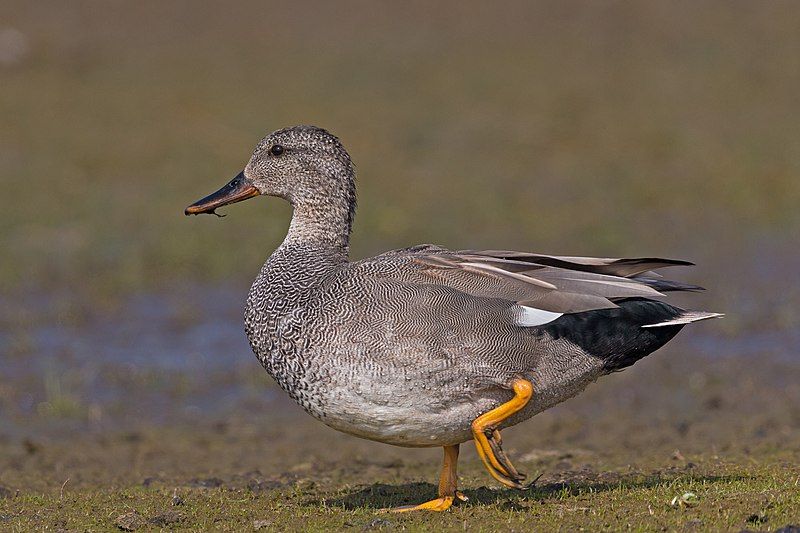
The gadwall is a type of duck found in many different places. It is part of the Anatidae family, which includes other ducks and geese.
Being a dabbling duck means the gadwall feeds by dipping its head underwater and grazing on plants and small invertebrates.
It doesn’t dive underwater like some other ducks do. The gadwall is known for its widespread distribution, meaning it can be found in many different regions worldwide. It can be seen in North America, Europe, Asia, and even Africa.
One reason for the gadwall’s wide distribution is its adaptability. It can thrive in various habitats, including freshwater marshes, lakes, and ponds. It can also be found in coastal areas like estuaries and saltwater marshes.
The gadwall is a relatively common duck, which is not rare or endangered. It is often seen in large flocks, especially during migration periods.
These flocks can consist of both males and females and young gadwalls. The male gadwall has a distinctive appearance.
It has a grayish-brown body with a black rear end and a white belly. Its head is primarily gray with black.
| Kingdom | Animalia |
| Phylum | Chordata |
| Clade | Dinosauria |
| Class | Aves |
| Order | Anseriformes |
| Family | Anatidae |
| Genus | Mareca |
| Species | M. strepera |
41. Song Sparrow

The song sparrow is a type of sparrow found in North America. It is considered to be medium-sized in comparison to other sparrows. Out of all the sparrows native to North America, the song sparrow is known to be one of the most abundant species.
This means that there are a large number of song sparrows in the wild. Not only is the song sparrow abundant, but it is also quite variable. This means that there can be different variations or types of song sparrows. They may have slight differences in appearance or behavior.
In addition to being abundant and variable, the song sparrow is also adaptable. This means that it can adjust well to different environments and conditions. It can thrive in various habitats, such as grasslands, marshes, and urban areas.
The adaptability of the song sparrow allows it to have a wide range of distribution. It can be found in many parts of North America, from Canada to Mexico. Overall, the song sparrow is a fascinating medium-sized, abundant, variable, and adaptable bird.
Its ability to adapt to different environments has contributed to its success as a species in North America.
| Kingdom | Animalia |
| Phylum | Chordata |
| Clade | Dinosauria |
| Class | Aves |
| Order | Passeriformes |
| Family | Passerellidae |
| Genus | Melospiza |
| Species | M. melodia |
42. Eastern Bluebird
The eastern bluebird is a type of bird native to North America. It is known for its ability to migrate or travel from one place to another.
It prefers to live in open woodlands, farmlands, orchards with plenty of trees and open spaces. One notable feature of the eastern bluebird is its bright blue breeding plumage.
The male bluebird has this vibrant blue color on its feathers during the breeding season. This makes it easy to spot and observe when perched on a wire or in an open area.
Many birdwatchers, also known as birders, find the eastern bluebird a favorite species to observe because of its striking appearance. The blue color of the male bluebird’s feathers is often associated with the breeding season.
It is a way for the male to attract a mate and signal its reproduction readiness.
The bright plumage acts as a visual cue for potential mates, indicating that the male is healthy and capable of producing offspring. In addition to its blue feathers, the eastern bluebird has other distinctive physical characteristics.
It iis smaller than other birds, allowing it to maneuver easily in its woodland and farmland habitats.
| Kingdom | Animalia |
| Phylum | Chordata |
| Clade | Dinosauria |
| Class | Aves |
| Order | Passeriformes |
| Family | Turdidae |
| Genus | Sialia |
| Species | S. sialis |
43. Purple Finch
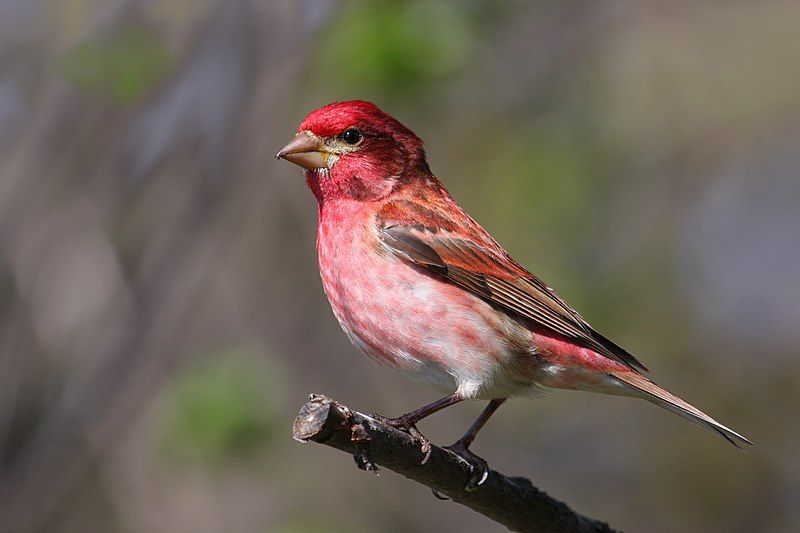
The purple finch is a type of bird. It belongs to the finch family called Fringillidae. This family includes various species of finches. The purple finch is one of them. This bird is found in different parts of North America.
It breeds in the northern United States, laying eggs and raising its young there. It also breeds in southern Canada, the region located below the north part of Canada.
Additionally, the bird can be found along the west coast of North America. Breeding refers to the process of reproduction in animals, where they mate and produce offspring. Like the purple finch, birds build nests and lay eggs for breeding.
They take care of their eggs until they hatch, then raise their chicks until they are ready to leave the nest. The purple finch is known for its vibrant purple coloration.
Males have a deep red or raspberry-colored plumage with a purple tint, while females have a more subdued plumage with streaks of brown and white.
This difference in appearance between males and females is called sexual dimorphism. In addition to its striking color, the purple finch has a sturdy beak well-suited for cracking open seeds.
| Kingdom | Animalia |
| Phylum | Chordata |
| Clade | Dinosauria |
| Class | Aves |
| Order | Passeriformes |
| Family | Fringillidae |
| Genus | Haemorhous |
| Species | H. purpureus |
44. Cedar Waxwing
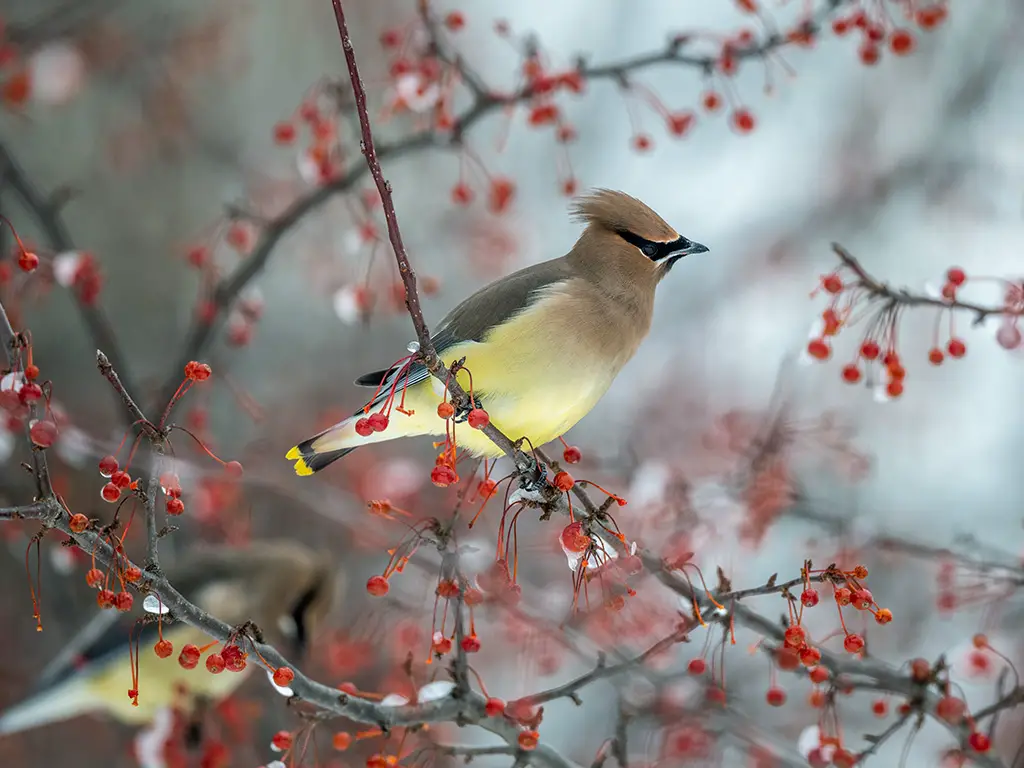
The cedar waxwing is a type of bird that belongs to the waxwing family of passerine birds known as Bombycillidae. Passerine birds are perching birds, which means they have feet adapted for gripping branches.
The cedar waxwing is a medium-sized bird with a distinctive appearance. Its feathers are mostly brown, gray, and yellow.
These colors help the bird blend well with its surroundings, making it harder for predators to spot it. One of the most unique features of the cedar waxwing is its wings. The bird gets its name from the wax-like tips on its wings.
These wing tips look like they have been dipped in wax, giving the bird a fascinating and memorable look. The wax-like wing tips serve a purpose for the cedar waxwing. They are specialized feathers that help the bird in various ways.
The waxy substance on the wing tips repels water, allowing the bird to fly more easily in wet weather conditions. It also helps the bird glide smoothly, reducing air resistance. Another exciting aspect of the cedar waxwing is its diet.
This bird primarily feeds on fruits, such as berries, and small fruits, like cherries. It has a unique adaptation in it.
| Kingdom | Animalia |
| Phylum | Chordata |
| Clade | Dinosauria |
| Class | Aves |
| Order | Passeriformes |
| Family | Bombycillidae |
| Genus | Bombycilla |
| Species | B. cedrorum |
45. White-Throated Sparrow
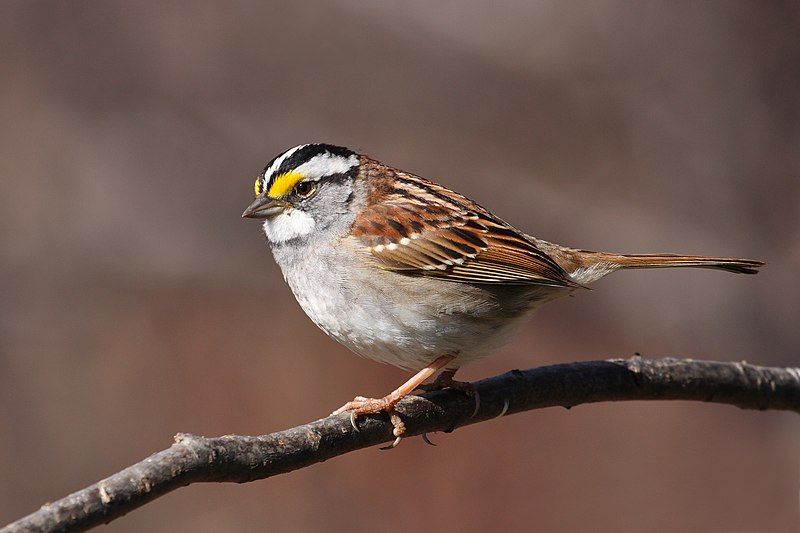
The white-throated sparrow is a type of bird that belongs to the passerine family called Passerellidae. This family of birds is commonly known as New World sparrows. Passerines are a diverse group of birds that make up more than half of all bird species.
They are known for their unique ability to perch and grip onto branches with their feet. The white-throated sparrow is easily distinguished by the white patch on its throat. This feature gives the bird its name.
These sparrows are native to North America and can be found throughout the continent, from Canada to Mexico. They are migratory birds, meaning they travel long distances during certain times of the year.
During the breeding season, white-throated sparrows are known for their distinct song, which can be described as a whistling “Oh sweet Canada, Canada, Canada.” This song helps them attract mates and establish their territory.
White-throated sparrows are relatively small birds, measuring about 6 to 7 inches long. They have plump bodies with a rounded head and a short tail. Their plumage consists of a combination of gray, brown, and black feathers.
| Kingdom | Animalia |
| Phylum | Chordata |
| Clade | Dinosauria |
| Class | Aves |
| Order | Passeriformes |
| Family | Passerellidae |
| Genus | Zonotrichia |
| Species | Z. albicollis |
46. Brown Thrasher
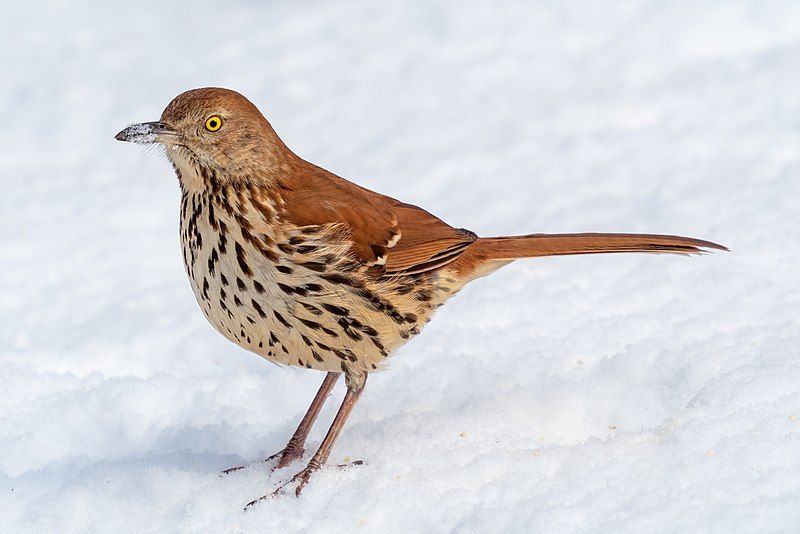
The brown thrasher is a bird that belongs to the family Mimidae. This family includes other birds like the New World catbirds and mockingbirds.
It is important to note that sometimes, people mistakenly refer to the brown thrasher as the brown thrush or fox-colored thrush. The brown thrasher has a distinct appearance with its brown feathers.
Its coloration resembles a fox, so it is sometimes called the fox-colored thrush.
However, it is essential to remember that it is not a thrush but a member of the Mimidae family. As a member of the Mimidae family, the brown thrasher shares similarities with other birds in this group.
Mimidae birds are known for their ability to mimic the sounds and songs of other birds. While the brown thrasher is not as famous for its mimicry skills as mockingbirds, it can still imitate some sounds. The brown thrasher is primarily found in North America.
Its range extends from southern Canada to central Mexico. It prefers habitats such as dense shrubs, woodland edges, and overgrown fields. These areas provide the birds with plenty of cover and food sources. In terms of size, the brown thrasher is medium-sized.
| Kingdom | Animalia |
| Phylum | Chordata |
| Clade | Dinosauria |
| Class | Aves |
| Order | Passeriformes |
| Family | Mimidae |
| Genus | Toxostoma |
| Species | T. rufum |
47. Yellow-Bellied Sapsucker
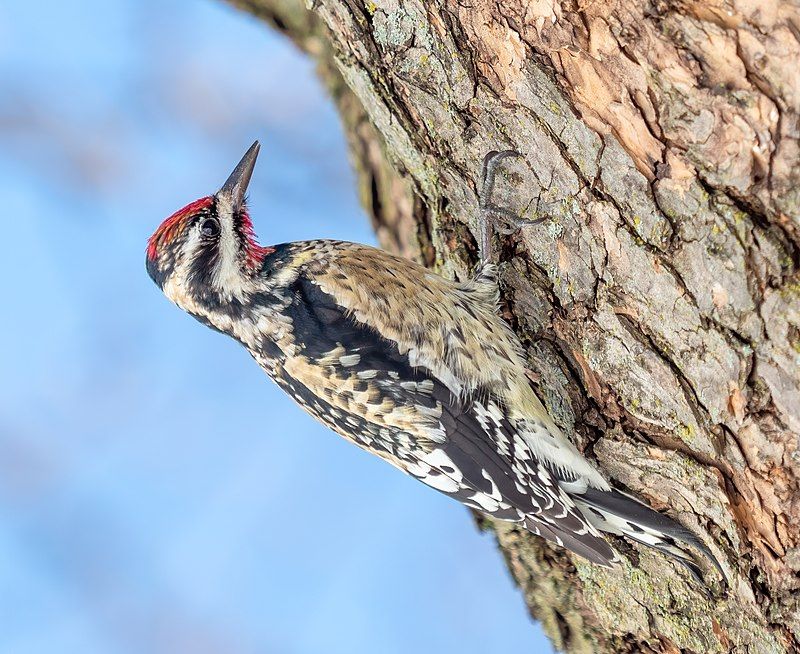
The yellow-bellied sapsucker is a bird that belongs to the woodpecker family. It is not too big or too small, but rather a medium-sized bird. This bird can be found in two specific regions: Canada and the northeastern part of the United States.
The yellow-bellied sapsucker is known for its distinct appearance. It has a yellow belly, where it gets its name. This bright yellow color stands out against the bird’s black and white feathers. This woodpecker has a unique behavior when it comes to feeding.
It mainly relies on tree sap as its primary food source. It drills tiny holes in tree trunks using its strong beak and long tongue to extract the sap. This behavior of drilling holes is why it is called a sapsucker.
Apart from sap, this bird also feeds on insects, fruits, and berries. It has a diverse diet, including insects like ants, beetles, and caterpillars. Additionally, it enjoys consuming fruits and berries when they are available.
Breeding is an essential aspect of the yellow-bellied sapsucker’s life cycle. It chooses to breed in two specific regions, Canada and the northeastern part.
| Kingdom | Animalia |
| Phylum | Chordata |
| Clade | Dinosauria |
| Class | Aves |
| Order | Piciformes |
| Family | Picidae |
| Genus | Sphyrapicus |
| Species | S. varius |
48. Carolina Wren
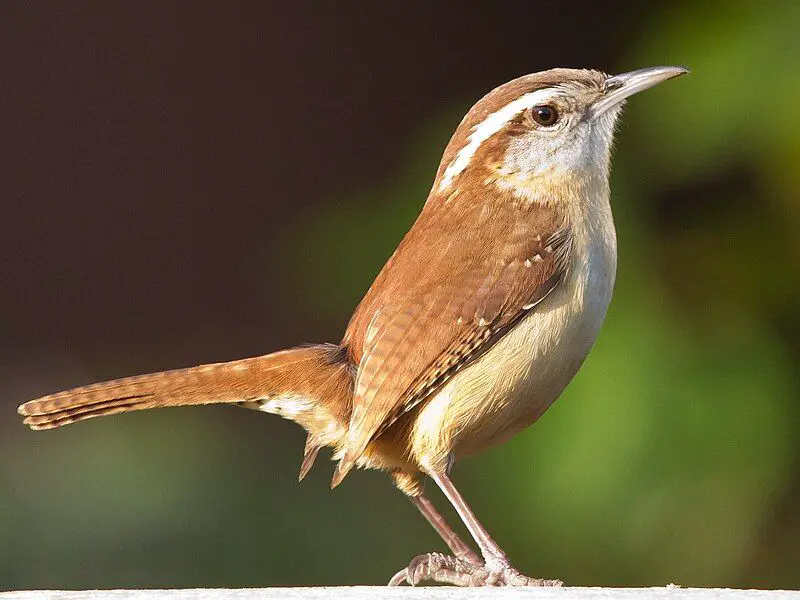
The Carolina wren is a type of wren bird found in several regions. It is considered a common species, frequently seen in these areas. The bird is mainly found in the eastern half of the United States of America.
This includes states like North Carolina, South Carolina, and Virginia. However, it can also be spotted in other states within this region. Apart from the United States, the Carolina wren is also seen in certain parts of Canada.
Specifically, it can be found in the extreme south of Ontario. This means it is only present in the southernmost part of the province.
This is interesting because the bird’s range extends beyond the borders of the United States. Additionally, the Carolina wren can be observed in the extreme northeast of Mexico.
This means it is in the country’s northeastern part, close to the border it shares with the United States.
This further highlights the bird’s ability to inhabit different regions within North America. The Carolina wren is a resident bird in the eastern half of the United States, the extreme south of Ontario, Canada, and the extreme northeast of Mexico.
It is a common species, often seen in these areas. Its range includes several states.
| Kingdom | Animalia |
| Phylum | Chordata |
| Clade | Dinosauria |
| Class | Aves |
| Order | Passeriformes |
| Family | Troglodytidae |
| Genus | Thryothorus |
| Species | T. ludovicianus |
49. Pine Siskin
The pine siskin is a type of bird found in North America. It belongs to the finch family, which includes other small birds like sparrows and goldfinches.
The pine siskin is known for its ability to migrate, meaning it travels from one place to another depending on the season. During the winter, the pine siskin’s range becomes very unpredictable.
It moves around sporadically instead of following a specific pattern or staying in one place.
Predicting where precisely these birds will be during the winter months can be challenging. The reason behind the pine siskin’s sporadic winter range is not entirely understood.
It is believed that factors like food availability and weather conditions play a role in determining their movements.
When specific food sources become scarce in one area, the birds may move to another location in search of better resources. The pine siskin’s winter range can vary from year to year.
One winter, they might be seen in large numbers in a particular region, while the following winter, they may be scarce or absent from the same area.
This unpredictability adds to the bird’s unique characteristics and makes it an interesting species to study. Researchers and bird enthusiasts often.
| Kingdom | Animalia |
| Phylum | Chordata |
| Clade | Dinosauria |
| Class | Aves |
| Order | Passeriformes |
| Family | Fringillidae |
| Genus | Spinus |
| Species | S. pinus |
Conclusion
Winter birds in Nebraska exhibit fascinating adaptations and behaviors that allow them to thrive in harsh winter conditions. They utilize various strategies, such as migration, foraging techniques, and shelter-seeking behaviors, to ensure survival.
Nebraska’s diverse habitats provide ample opportunities for birdwatchers to observe many winter bird species, making the state a popular destination for bird enthusiasts.
Studying and appreciating these winter birds enhances our understanding of their ecological role and highlights the importance of preserving their habitats for future generations.